De Gulden Passer. Jaargang 83
(2005)– [tijdschrift] Gulden Passer, De–
[pagina 1]
| |||||||||||||||||||||||||||||||||||||||||||||||||||||||||||||||||||||||||||||||||||||||||||||||||||||||||||||||||||||||||||||||||||||||||||||||||||||||||||||||||||||
Hendrik D.L. Vervliet
| |||||||||||||||||||||||||||||||||||||||||||||||||||||||||||||||||||||||||||||||||||||||||||||||||||||||||||||||||||||||||||||||||||||||||||||||||||||||||||||||||||||
[pagina 2]
| |||||||||||||||||||||||||||||||||||||||||||||||||||||||||||||||||||||||||||||||||||||||||||||||||||||||||||||||||||||||||||||||||||||||||||||||||||||||||||||||||||||
series of new and very superior Romans, which grew into the norm for Roman type design in the times to come (Barker, 1974). The prestigious name of Garamont is often affixed to the new style, though there is no proof that the master was involved in their cutting (Vervliet, 2004, 114-5). In any case, from that fourth decade of the sixteenth century onwards, Parisian type design becomes full-grown and ready for worldwide expansion. This paper addresses three main points. First, it describes the coming-of-age of Parisian typography, illustrating how changing patterns of reading habits led Parisian typographers to invest substantially into designing and cutting new types à l'antique. The roles of Francis 1 (1515-1547) and his court, and of the theoretician Geoffroy Tory (1529) are frequently cited here, as well as the influence of the numerous Italian scholars and artists, that France received so warmly, mainly in the 1520s and 1530s. However, it should become clear that in Paris the seasoning of a general, i.e., non-humanistic, reading public to Roman letterforms started much earlier, viz. at the very beginning of the 1500s. Second, the struggle between two models of type procurement, viz. individual ownership of punches and matrices vs. concentration in and commercialization through typefoundries. The first model was the rule in the first years after the invention of printing; the second (which was to exist into the twentieth century) became the standard from the end of the sixteenth and the seventeenth century onwards, when great regional typefoundries emerged in Frankfurt, Paris, Amsterdam, and Leipzig. The period in between was more or less chaotic: punchcutters, typefounders, printers, and publishers competing in the same market of type procurement. This study illustrates the confusion. Third, there is the tantalizing problem of identifying the punchcutters involved. Names such as those of Nicolas i de Russangis, George Wolf, Guillaume Le Rouge, Petrus Caesaris, Martinus Caesar, Jean Vatel or Simon de Colines are quoted, but only the part of both last named can be established with some certainty. Admittedly in general the quality of the letterforms, as expressed by their evenness and balance, as far as covered here, is mostly unremarkable. However, this survey illustrates in how short a span of time Paris (and France) entered into the new era, that of a typographic Renaissance, in the years after 1520. It remains disheartening, though, that at the end of this inquiry one is unable to suggest any name of a punchcutter who could reasonably be linked to the celebrated Roman founts which Robert i Estienne introduced in 1530 (Vervliet, 2004, 116). | |||||||||||||||||||||||||||||||||||||||||||||||||||||||||||||||||||||||||||||||||||||||||||||||||||||||||||||||||||||||||||||||||||||||||||||||||||||||||||||||||||||
1. SourcesTo the best of my knowledge the earliest archival documents describing French typefaces surface in the early 1520s in the estate inventories of Parisian booksellers or printers. However, apart from a single attribution of a Gothic typeface to Gaspar Trechsel of Lyons in the 1522-24 Hopyl inventory (Stein, 1905, 183), none of them allows us to ascertain the origin of the founts. Two other archival records, though only preserved in seventeenth and eighteenth-century copies, are of great importance for the history of French palaeotypography, basically for the period after 1530. They originate indirectly from the typefounder Guillaume i Le Bé (1523-98), a younger contemporary of Claude Garamont. The first document is an inventory of Le Bé's typefoundry, preserved in an eighteenth-century copy in the hand of the elder | |||||||||||||||||||||||||||||||||||||||||||||||||||||||||||||||||||||||||||||||||||||||||||||||||||||||||||||||||||||||||||||||||||||||||||||||||||||||||||||||||||||
[pagina 3]
| |||||||||||||||||||||||||||||||||||||||||||||||||||||||||||||||||||||||||||||||||||||||||||||||||||||||||||||||||||||||||||||||||||||||||||||||||||||||||||||||||||||
Fournier (Paris, Arch. nat., mc 65, f. 229; Morison, 1957). The original is lost but must have been written or updated by Guillaume ii Le Bé probably around 1618 (Carter, 1967, p. 11, n. 6). This inventory mentions two Roman founts by Colines, belonging to the period considered here; they are described below (35 and 39). The second Le Bé document is a memorandum of chiefly biographical notes about French punchcutters, typefounders and printers active in the sixteenth and the early seventeenth centuries (Carter, 1967). Its first part was compiled and written by the same Guillaume ii Le Bé about 1643. His father evidently was the main source for the earlier part of the story. The memorandum mentions a ‘Petit-texte’ Roman of Colines, referring no doubt to the Minion described below (39). In addition, there are some references in contemporary correspondences of scholars such as Budé, Erasmus, Giustiniani, Vatel (Secret, 1963, 269; Vervliet, 2002, 10-15). At first sight, they concern the availability of Greek or Hebrew faces, but indirectly illustrate the ways of procurement of new type designs in Paris at the end of the 1510s. Finally and, in substance, mainly, there are the books preserved from the period covered by this study: Moreau's Inventaire chronologique lists some 6,300 titles for the period surveyed here. In a few of them, the colophon refers to the types used, mostly to praise them. It seldom says anything substantial about their maker and in that respect the harvest is meagre. However, the books themselves, if properly dated, are telling witnesses. By trying to distinguish new or unusual faces, some hypotheses about their origin or maker may be ventured. That implies an overview as large as possible not only of Parisian books but of books printed elsewhere as well. Such exhaustiveness, however necessary, is a task that, given my resources, is unfulfillable within a limited time span. In addition, as I have only been able to inspect a small minority, perhaps less than one fourth, of the corpus, I must ask for indulgence for any incompleteness or other shortcomings. | |||||||||||||||||||||||||||||||||||||||||||||||||||||||||||||||||||||||||||||||||||||||||||||||||||||||||||||||||||||||||||||||||||||||||||||||||||||||||||||||||||||
2. The Romanization of French typographyIn the Romanization of French typography four waves can be distinguished, viz.:
In 1470 France was slowly recovering from the devastations of the Hundred Years Wars (1337-1453) and despite continuing attacks by the English and Burgundian armies, in cultural and intellectual life, the French were ready to adhere to the new ways of thinking prevailing in Italy, or to the newly invented mechanical methods of book production such as those of Germany. As to the latter field, the names of Gutenberg, Fust, and Schoeffer were not unknown in the French capital of the 1460s, but at its very beginning Parisian typography preferred to follow Italian rather than German type designs and to start with Roman (or Roman-like) founts. The first Parisian printers in the years 1470-72 were three German craftsmen, Michael Friburger, Ulrich Gering, and Martin Krantz, recruited by the Sorbonne scholars Guillaume Fichet and Joannes Heynlin. They had just one fount, a Roman, which they used only up to 1472, opting for Gothic in the later part of their career (1473-78). Both the | |||||||||||||||||||||||||||||||||||||||||||||||||||||||||||||||||||||||||||||||||||||||||||||||||||||||||||||||||||||||||||||||||||||||||||||||||||||||||||||||||||||
[pagina 4]
| |||||||||||||||||||||||||||||||||||||||||||||||||||||||||||||||||||||||||||||||||||||||||||||||||||||||||||||||||||||||||||||||||||||||||||||||||||||||||||||||||||||
following Parisian printer, Petrus Caesaris, and the press housed Sub signo follis viridis (Soufflet vert), active in 1473-74 and 1475-76 respectively, also used some kind of Roman typeface. Gering returned to Roman type in 1478 when he alone became head of the press, starting out with two new Roman founts. They were his sole assortments, until after his association with Bertold Rembolt in the mid 1490s, half a dozen Gothic founts made their appearance. Gering's Roman founts were ostensibly proprietary founts only available in the 1480-90s to Gering's associates or assistants Maynyal, Wolf, Rembolt and Higman. They remained in use until the 1520s and early 1530s at the presses of Gromors and Chevallon (probably through the latter's marriage with the widow of Bertold Rembolt). Gering used Roman indiscriminately, even for subjects which later Parisian printers tended to set in Gothic. After these pioneering years, as printing became accepted within the thriving Parisian booksellers' guild, a concession to the Gothic tastes of the Parisian customer was made: in the 1480s major Parisian printers such as Bonhomme, Marchant, Vérard, Pigouchet, and Trepperel, published exclusively in Gothic type, including those works of classical or Neo-Latin authors, which, in later years, would conventionally be printed in Roman. Vérard, Pigouchet, Trepperel, whose careers extend into the 1510s, never had or used Roman type: Parisian typography became as Gothic as the cathedral of Notre-Dame. Within Gothic, the formal Gothics, such as Texturas (lettres de forme) or Rotundas (lettres de somme) had a status differing from the current form of the French Gothic hand, the Bastarda (Bâtarde, lettre bourgeoise). As far as the printer's assortments went, the former were used as text types for ‘serious’ works in Latin, the latter for works in the vernacular. But that was a custom, not an iron rule. A second wave occurred in the 1490s, when Wolf changed his old Gering Romans for new founts which he shared with Kerver a few years later. Parisian printing was moving nearer to the mos Italicus, where Roman prevailed. From then onwards Parisian publishers were beginning to publish classical and Neo-Latin authors as a standard in Roman, while other matter remained in Gothic. Parisian printers would adhere to this convention well into the 1520s, except perhaps Thielman i Kerver from 1503 onwards. Kerver began his publishing career in 1497 as a bookseller and from 1498 until his death in 1522 he owned a press, using initially the typographical materials of Wolf and Philippi. His earlier publications mainly pertain to classical or Neo-Latin authors. Later he appears to have narrowed his scope to liturgical and devotional books. In the latter domain he shared the lucrative market of the Horae Beatae Mariae Virginis with Pigouchet, Vérard, and Hardouyn. In that specific domain, Paris enjoyed a kind of monopoly, publishing a yearly average of twelve Hours (as far as preserved) during the first two decades of the sixteenth century. Kerver's average in that field was three Hours a year. Availability of founts was no problem for Kerver. He had a well-assorted stock of types: Gothics, Romans and in the 1510s, Italics. The use of these founts is, at least in the beginning of his career, wholly regular: Gothic for liturgical and prayer books, both in Latin or the vernacular, Roman for texts which could interest a humanistic readership. In 1503, however, he started an experiment, publishing a Latin Book of Hours in Roman - the first but not the last, as far as Kerver is concerned, of a series to come (Moreau, 1:103, no. 62; Oxford, Bodleian Library, Douce bb 26). The response of the Parisian readership must have been positive. In the following years Kerver (and he alone) pursues the Romanization, even intensifying the | |||||||||||||||||||||||||||||||||||||||||||||||||||||||||||||||||||||||||||||||||||||||||||||||||||||||||||||||||||||||||||||||||||||||||||||||||||||||||||||||||||||
[pagina 5]
| |||||||||||||||||||||||||||||||||||||||||||||||||||||||||||||||||||||||||||||||||||||||||||||||||||||||||||||||||||||||||||||||||||||||||||||||||||||||||||||||||||||
effort. Up to 1510 about one third of his Hours are set in Roman, the percentage rising in the second decade to eighty percent (if for the purpose of the present discussion we may add Italic to Roman). To be sure, the Hours involved were in Latin, with a few paragraphs in French. Sections in French - almanac, calendar, side-notes - remain presented in Gothic. The presence of French texts seems to imply that the production was not primarily intended for export, say to Italy. It should be remarked that Kerver confined the Romanization to his Books of Hours and did not introduce the change in his missals or other liturgical publications. Probably he sensed a readiness to accept Hours - which was the book par excellence and often the sole book of the common devout homo unius libri - in the new letterform (Vervliet, 2004a). The fourth and final phase in the process of Romanization occurs in the 1520s, when Parisian printing starts to use Roman for its publications in vernacular. That too was following an Italian trend, introduced in the 1470s, where Venice's first printers, Joannes de Spira and Nicolas Jenson, used Roman for their Petrarca (1470) and Plinius editions in Italian (1476). The first press had no choice in 1470, but the second owned several Gothics at the time of publication. In Paris, the Romanization of vernacular printing started at the very end of the 1510s. It has been suggested that the French court was involved in this change (Carter, 1969, 80; Martin, 2000, 183-95), because, apart from the Heures... selon lusage de Rome (Tory [& Colines], 1525), the titles involved seem to reflect the interest that an italophile Francis i and his court may have had in their subject: Platina's Genealogies, dedicated to Marguerite d'Angouleme (Galliot Du Pré & Vidoue, 1519), a summary in French of Budé's De asse, made at the king's request (id., 1522),and the Seyssel translations which Francis i had ordered published, beginning with the Thucydides (Badius, 1527). The printers were Colines, Vidoue and Badius. They relied on the Roman types they owned and used regularly for their other humanistic editions. In the field of typography, the expanding Romanization and the growing popularity of humanism can easily be quantified: in the two latest decades of the fifteenth century six new Roman founts appeared (one of which was imported from abroad). In the first decade of the sixteenth century, four Romans (two imported) and one Greek appeared. In the second decade, the count rises to thirteen new Romans, eight Italics, one Hebrew (none of them imported) and a few Greeks (one imported). In the 1520s eighteen new Romans appear (three imported), five Italics (one imported), two Hebrews (one imported), six or seven Greeks (two imported) and two music faces. | |||||||||||||||||||||||||||||||||||||||||||||||||||||||||||||||||||||||||||||||||||||||||||||||||||||||||||||||||||||||||||||||||||||||||||||||||||||||||||||||||||||
3. Towards an independent type tradeAs a rule, so the handbooks tell us, a fifteenth-century press went for an in-house production of type including its design, cutting, and casting. Our incunabula catalogues and descriptions of adespota are based on this principle of individual ownership of founts. As always, however, there are exceptions to the rule and these seem to increase from the 1490s onwards. Towards the middle of the sixteenth century the reverse was the norm, with printers only rarely owning proprietary founts. The following case studies may help to illustrate the situation in Paris. | |||||||||||||||||||||||||||||||||||||||||||||||||||||||||||||||||||||||||||||||||||||||||||||||||||||||||||||||||||||||||||||||||||||||||||||||||||||||||||||||||||||
[pagina 6]
| |||||||||||||||||||||||||||||||||||||||||||||||||||||||||||||||||||||||||||||||||||||||||||||||||||||||||||||||||||||||||||||||||||||||||||||||||||||||||||||||||||||
The ‘Gering’ Pica (2) offers an example of the pristine situation when individual ownership of a type was the rule - the term ‘individual’ as used here implies it was not shared with other presses, except if associated. The Gering Pica originated at Gering's press in 1478 and was used there and later at the presses of his partners and successors, Maynyal, Higman, Wolf, and Rembolt; the latest use is in the 1520S-1530S at the press of Chevallon, who had married Rembolt's widow, Charlotte Guillard. We do not know who may have cut that face. Wolf is a possible candidate; he used the face for a couple of years after he left Gering and before he had or had another one made of the same size, which he shared with Kerver (6). This pattern of individual (or restricted) use of home-made founts is the usual one in Paris during the period considered here. It is also Kerver's model and towards the end of our period, that of Colines and Robert i Estienne. A variant of this model is offered by the ‘Ruel’ Great Primer (13). Ostensibly it was in use at three presses, viz. those of Henry i Estienne, Le Rouge, and Maheu. But its use by them was sequential and therefore it is suggested here that the fount was property of a bibliophile, perhaps Ruel, who sponsored the printing of selected publications. A second case is the propietary use of a set of matrices. This implies that other presses may use the same face, though cast on another set of matrices. A good example of this model is offered by two founts of Badius, his Great Primer and Pica (3 and 4). It appears that they were also used in Venice, Genoa, Augsburg, and Lyons. If so, such a spread seems to preclude the sale of cast type and to imply the sale of strikes or matrices. However, it is noteworthy that Badius, once in possession of his beloved litterae Italicae, used these Roman founts in the same incunabular fashion as his predecessors. At least, I know of no other usersin Paris. Whether that implies that he owned his own typefoundry is more difficult to tell. It is quite possible that he simply contracted a founder to cast on his matrices. A final case implies the existence of independent typefoundries, owning their own matrices and selling cast type to other printers, i.e. the pattern that will prevail in the later half century. Two faces are representative for this model: the Bergmann Great Primer (5) and the Tholoze Pica (8). Both were common to the majority of Parisian printers using them from the late 1490s until well into the 1530s. On a smaller scale the Gourmont 1503 Greek (Vervliet, 2002, 7-9), the 1519 Desprez and 1525 Vidoue titlings (16 and 33) are examples of the same phenomenon. The spread of these faces and their lifetime indicate that at least matrices were available in Paris and that a local typefounder probably supplied cast type to those printers who could not afford (or did not want) to invest in privately owned typefounding resources. The number of Parisian Roman founts that were proprietary greatly outnumbers those which were in floating use: some forty-six against five. But when printed titles are concerned, the reverse can be observed. In this case, the Bergmann and Tholoze Romans, and later the Desprez and Vidoue titlings may be met in one case out of two. That a Le Rouge-Desprez-Savetier typefoundry was serving a sizable part of the open Parisian market is a tempting hypothesis. | |||||||||||||||||||||||||||||||||||||||||||||||||||||||||||||||||||||||||||||||||||||||||||||||||||||||||||||||||||||||||||||||||||||||||||||||||||||||||||||||||||||
4. The growth of a craftIf independent typecasters were active, does that imply that independent punchcutters were available too? Not necessarily, but it is highly probable that, in a world centre of book trade | |||||||||||||||||||||||||||||||||||||||||||||||||||||||||||||||||||||||||||||||||||||||||||||||||||||||||||||||||||||||||||||||||||||||||||||||||||||||||||||||||||||
[pagina 7]
| |||||||||||||||||||||||||||||||||||||||||||||||||||||||||||||||||||||||||||||||||||||||||||||||||||||||||||||||||||||||||||||||||||||||||||||||||||||||||||||||||||||
such as Paris, they were. Paris played a great role in the manufacture and trade of Gothic types, though we do not know the names of their engravers (Shaw, 1980). The import of foreign Roman founts was, in any case, limited. Italy supplied the two bigger sized Romans of Badius (3 and 4). Imports from Germany were more substantial. At the end of the 1490s the Bergmann Great Primer (5) was supplied from Basle and became the most used Parisian Roman in its size. In the 1520s, a few years after the first appearance in Paris of the Urs Graf and Hans Holbein the Younger illustrations and decorations (Billeter, 1962, 47), German typefaces such as the Quentel Small Pica (9), the Cervicornus Pica (14), the Lotter Long Primer (18), and perhaps the Vidoue Brevier (27) surfaced. Their acceptance was limited. In the period covered by this paper, Simon de Colines (15) and Jean Vatel (25) are the only more or less certain names that may be associated with letter engraving. Both seem to have worked only for their own presses. George Wolf too (6), if it can be established that he was a punchcutter. Some of his faces were later in the possession of Guillaume Le Rouge (7), another candidate-engraver but who, in first instance, may have been a typecaster. The roles of Nicolas i de Russangis (1), Petrus Caesaris (12), Martin Caesar, Le Rouge's supposed son-in-law (12), and Nicolas Desprez (16), can for the time being only be surmised. The Gothic typefaces and Attaignant music founts attest to the technical competence of Parisian punchcutters. However, on the aesthetic side the autochtonous Parisian Romans look unbalanced and lacking evenness and symmetry. Many of them are unattractive and their readability is weak. Apart from the Tholoze Master (1499) and (at least from 1524 onwards) Colines, none of them produced Roman, Italie, Greek or Hebrew founts which could compete aesthetically with the better ones offered by Italian or Basle typography. If any great talent was active in Paris during these first three decades of the sixteenth century, besides the Tholoze Master and Colines, he must have been working on Gothic types. while the number of new founts dramatically increases in the third decade, the average quality remains low. As far as new Roman designs are concerned, there is, in the period studied here -and again apart from Colines, no direct indication of the coming explosion of new talents in Paris during the 1530s with names such as those of Antoine Augereau, Francis Gryphius, the Estienne and Buffet Masters, Jean Arnoul dit Picard, and Claude Garamont. | |||||||||||||||||||||||||||||||||||||||||||||||||||||||||||||||||||||||||||||||||||||||||||||||||||||||||||||||||||||||||||||||||||||||||||||||||||||||||||||||||||||
5. MethodologyIn the following descriptions, the founts are identified by the names of their cutter, or, if an attribution is impossible or questionable, by the names of a first user or patron (or by the author's name or title if the printer or patron is unknown). In such cases, the name is presented within inverted commas. The formula used to indicate the type size is adapted from the Proctor/Haebler convention, as follows: 20 the measurement of 20 unleaded lines in mm x the height of a short lowercase in mm : the height of an average capital (preferably an I or H) in mm.
For example, 20 100 × 2.2: 3.2 mm. | |||||||||||||||||||||||||||||||||||||||||||||||||||||||||||||||||||||||||||||||||||||||||||||||||||||||||||||||||||||||||||||||||||||||||||||||||||||||||||||||||||||
[pagina 8]
| |||||||||||||||||||||||||||||||||||||||||||||||||||||||||||||||||||||||||||||||||||||||||||||||||||||||||||||||||||||||||||||||||||||||||||||||||||||||||||||||||||||
The requirement that the measurement be taken from unleaded lines is essential. If impossible or difficult, it has been suggested multiplying the ph-measure (the ‘gauge’) by 20 (Vervliet, 1968, 18; Carter, 1969, 23). However, in spite of their mathematical look, these measurements are approximate. Even the measurement of 20 unleaded lines is exposed to change with the typefounders mould, which frequently was borrowed from the printer's ready stock or was locally made (Gaskell, 1974, 15-6), and could be adjusted upwards by inserting body brasses. Uneven wetting too may cause differently shrinking of the handmade paper, even within the same book. It therefore makes little sense to distinguish an 80 mm face from a 79 or 81 mm by measurement alone. Finally, the apparent measure of single sorts as given in the second or third component of the above formula can be inflated by a coarse inking or be hard to ascertain because of unevenly designed sorts. Both the values given in Anglo-American and Didot points or the reconstructed ancient size names are, at best, approximate projections of the sixteenth-century type sizes (Tarr, 1946; Carter, 1969, 126; Gaskell, 1974, 14; Richardson, 1990). Size names appear in Parisian contracts from the 1520s onwards, but standardization began (with notable regional differences) only after the middle of the sixteenth century, several decades after the period considered here (Shaw, 1981). It must also be made clear what is meant by the terms fount, type, or typeface. For the purpose of this article a fount, or type, or typeface, is defined as any casting from any set of matrices derived from the same basic set of punches. This definition corresponds with the views expressed by palaeotypographers such as Johnson (1936, 70), Isaac (1938, ix) or Shaw (1980, 445). On the one hand it is narrower than that used by the today's desk top publishing business which equates the term fount/font with a whole typeface famiiy of a uniform design regardless of its size or weight. On the other hand, it is broader than the standard professional definition of manufacturer of hot type, as it ignores the traditional requirement for unity of time and place of casting. The same unity is also subsumed by the definition incunabulists tend to adopt. At the risk of disappointing students of particular presses, the definition as used in this paper also disregards minor variations (however important these accidentals may be when studying a specific press) that may occur in the phases of justifying, casting, rubbing, kerning, and dressing or may be caused by odd sorts or the inclusion or exclusion of peripheral sorts such as small capitals, spaces, ligatures, punctuation or numerals, which, in the sixteenth century, were not or not always included in a bill-of-fount (Davis-Carter, 1958, 19n). It also disregards slight differences in the position of diacritics, strokes or dots, as these may result from differences in matrices if stepped punches were used. The rubric ‘First seen in’ attempts to find the earliest date of occurrence of a given fount because of the date's importance when considering an attribution. On the contrary, the rubric ‘Early Appearances’, my heuristic being far from complete, does not offer completeness, however appropriate exhaustiveness might have been here for assessing correctly the networks of which ostensibly linked some printers and typefounders. Aiming to provide a broad, certainly non-exhaustive, idea of the spread and lifetime of the face, it mentions the date of the earliest occurrence of a fount at a given press, which I happened to notice. This rubric is merely intended to give a rough idea of the spread and users of a face and is to be considered as an indicative, rather than an exhaustive listing. In the same rubric the names of printers, publishers, and booksellers are given indis- | |||||||||||||||||||||||||||||||||||||||||||||||||||||||||||||||||||||||||||||||||||||||||||||||||||||||||||||||||||||||||||||||||||||||||||||||||||||||||||||||||||||
[pagina 9]
| |||||||||||||||||||||||||||||||||||||||||||||||||||||||||||||||||||||||||||||||||||||||||||||||||||||||||||||||||||||||||||||||||||||||||||||||||||||||||||||||||||||
criminately, the relations between those trade categories requiring more research than I was able to offer. Some publishers apparently owned type and decorative materials of their own (Parent & Veyrin-Forrer, 1974, 80; Veyrin-Forrer, 1987, 38). Consequently the ownership of type materials by a publisher or sponsor rather than by the printer, as well as the lending of materials between printers, deserves closer attention. Finally, the illustrations joined to the descriptions are unretouched and in actual size. | |||||||||||||||||||||||||||||||||||||||||||||||||||||||||||||||||||||||||||||||||||||||||||||||||||||||||||||||||||||||||||||||||||||||||||||||||||||||||||||||||||||
6. Conspectus of the fountsThe conspectus below and following descriptions present fifty-one Romans in order of date of their First occurrence in Paris or abroad. A table at the end of the article lists them by type size.
| |||||||||||||||||||||||||||||||||||||||||||||||||||||||||||||||||||||||||||||||||||||||||||||||||||||||||||||||||||||||||||||||||||||||||||||||||||||||||||||||||||||
[pagina 10]
| |||||||||||||||||||||||||||||||||||||||||||||||||||||||||||||||||||||||||||||||||||||||||||||||||||||||||||||||||||||||||||||||||||||||||||||||||||||||||||||||||||||
| |||||||||||||||||||||||||||||||||||||||||||||||||||||||||||||||||||||||||||||||||||||||||||||||||||||||||||||||||||||||||||||||||||||||||||||||||||||||||||||||||||||
[pagina 11]
| |||||||||||||||||||||||||||||||||||||||||||||||||||||||||||||||||||||||||||||||||||||||||||||||||||||||||||||||||||||||||||||||||||||||||||||||||||||||||||||||||||||
| |||||||||||||||||||||||||||||||||||||||||||||||||||||||||||||||||||||||||||||||||||||||||||||||||||||||||||||||||||||||||||||||||||||||||||||||||||||||||||||||||||||
[pagina 12]
| |||||||||||||||||||||||||||||||||||||||||||||||||||||||||||||||||||||||||||||||||||||||||||||||||||||||||||||||||||||||||||||||||||||||||||||||||||||||||||||||||||||
7. Type Descriptions1. The ‘Gering’ Roman on Large English [R 100] or Gros-texte (1478)This is the fourth Roman or Roman-like fount to appear in Paris in the 1470s. Coming after the fere-humanisticas of Friburger-Krantz-Gering, Petrus Caesaris and The Soufflet Vert, it has shed most Gothic reminiscences present in its Paris predecessors without, however, reaching the simple serenity of the 1470-73 Jenson Romans. We do not know who may have cut this face. Russangis and Wolf are the possible candidates. Russangis, possibly the medallist Nicolas i (Catalogue BM, 8: xx; Mazerolle, 1902, 1: cxlix; Renouard, 1965, 387; Veyrin-Forrer, 1987, 224), was one of associates in the Soufflet Vert, while George Wolf (Catalogue BM, 8: xxxii; Renouard, 1965, 436) used the Gering face during a couple of years after he left Gering and before he had or had made another one on the same size, which he shared with Kerver (6). Size: Large English (Gros-texte); 14/13.5 Anglo-American/Didot points; 20 100 × 2.2:3.2 mm. | |||||||||||||||||||||||||||||||||||||||||||||||||||||||||||||||||||||||||||||||||||||||||||||||||||||||||||||||||||||||||||||||||||||||||||||||||||||||||||||||||||||
[pagina 13]
| |||||||||||||||||||||||||||||||||||||||||||||||||||||||||||||||||||||||||||||||||||||||||||||||||||||||||||||||||||||||||||||||||||||||||||||||||||||||||||||||||||||
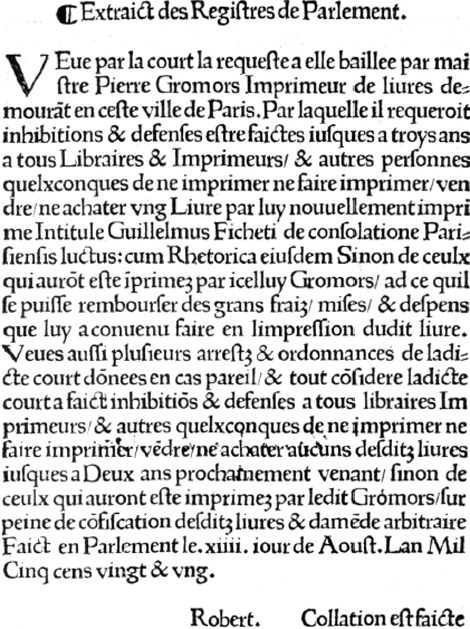 Fig. 1. The ‘Gering’ on Large English [r 100] or Gros-texte (1478) as it appears in G. Fichet, Consolatio luctus et mortis Parrhisiensis, Paris, P. Gromors, 1521, f. π1v. Courtesy of the Royal Library, The Hague.
| |||||||||||||||||||||||||||||||||||||||||||||||||||||||||||||||||||||||||||||||||||||||||||||||||||||||||||||||||||||||||||||||||||||||||||||||||||||||||||||||||||||
[pagina 14]
| |||||||||||||||||||||||||||||||||||||||||||||||||||||||||||||||||||||||||||||||||||||||||||||||||||||||||||||||||||||||||||||||||||||||||||||||||||||||||||||||||||||
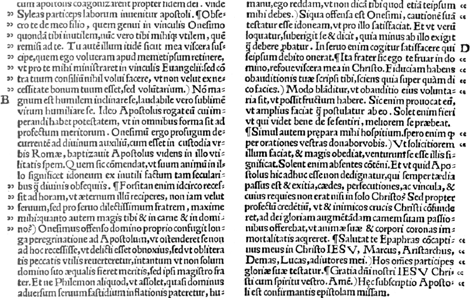 Fig. 2. The ‘Gering’ Pica [r 80] or Cicéro (1478) as it appears in Ambrosius, Omnia opera, Paris, Cl. Chevallon, 1529, p. 558. Courtesy of the Royal Library, The Hague.
| |||||||||||||||||||||||||||||||||||||||||||||||||||||||||||||||||||||||||||||||||||||||||||||||||||||||||||||||||||||||||||||||||||||||||||||||||||||||||||||||||||||
[pagina 15]
| |||||||||||||||||||||||||||||||||||||||||||||||||||||||||||||||||||||||||||||||||||||||||||||||||||||||||||||||||||||||||||||||||||||||||||||||||||||||||||||||||||||
2. The ‘Gering’ Pica Roman [r 80] or Cicéro (1478)A reduced version of the Gering Roman described above in (1) appeared at Gering's press a few weeks later. It was probably cut by the same unknown letter engraver. In the 1520s and early 1530s it occurs at the press of Claude Chevallon, probably via the dowry of his wife, Charlotte Guillard, the widow of Rembolt. Size: Pica (Cicéro); 11/10.5 Anglo-American/Didot points; 20 80 × 1.9:3 mm.  | |||||||||||||||||||||||||||||||||||||||||||||||||||||||||||||||||||||||||||||||||||||||||||||||||||||||||||||||||||||||||||||||||||||||||||||||||||||||||||||||||||||
[pagina 16]
| |||||||||||||||||||||||||||||||||||||||||||||||||||||||||||||||||||||||||||||||||||||||||||||||||||||||||||||||||||||||||||||||||||||||||||||||||||||||||||||||||||||
3. The ‘Capsaca’ Great Primer Roman [r 105] or Gros-romain (Venice, 1493; Paris, 1503)Badius's stay in Italy had aroused his interest in Roman typefaces well before he entered the printing trade. A passage in his introductory letter to Beroaldo's Orationes (Lyon, Trechsel, 1492, f. a2-a3; Gesamtkatalog, 4: 4145) alludes to his typographic preferences: ‘Dum... sciremque ipsum [i.e. Joannem Trechsel] italicam litteram paratam habere: qua tersius castigatiusque opus hoc imprimi posset’.Ga naar voetnoot5 However, when about 1503 he started his own printing press in Paris, he did not use the Trechsel fount, but a Venetian fount which can be associated with Capsaca's name. The type, the r 108 in the terminology of the Catalogue BM (5: 482), is quite similar but not identical to a group of several founts, originating in the 1470s and 1480s in Turin with J. Fabri [r 114], in Venice with B. Benali [r 110] and Ragazonibus [r 107b]. But the Capsaca r 108 and Bevilacqua r 107 founts, occurring in Venice from 1493 onwards, seem to be identical with the Badius face. Except for a single use in an imprint with Aliate's device (Renouard, 1964, 1: 18, no. 23 and pl. a8), I have not seen this face used in Paris, except by Badius's press, where it stayed in use up to 1535, and by Vascosan, Badius's son-in-law, in the first years of his career. Johann Amerbach's second Roman on this size (his r 110 in use in 1495-6) is similar to this face. More research is needed to ascertain whether or not both founts are identical (Catalogue BM, 3: 744 and pl. 72; GfT 89717). The same problem for the r 110 appearing at Dirk Martens's Antwerp press and other Low Countries presses from 1502 onwards (Nijhoff, 1926, 2: s.v., nos. 3, 4, sqq.) and the r 111 of Vietor in Vienna from 1510 onwards (Isaac, 1938, 243 and pl. 13). Size: Large English/Great Primer (Gros-texte/Gros-romain); 15/14 Anglo-American/Didot points; 20 105 × 2.1: 3.6 mm. | |||||||||||||||||||||||||||||||||||||||||||||||||||||||||||||||||||||||||||||||||||||||||||||||||||||||||||||||||||||||||||||||||||||||||||||||||||||||||||||||||||||
[pagina 17]
| |||||||||||||||||||||||||||||||||||||||||||||||||||||||||||||||||||||||||||||||||||||||||||||||||||||||||||||||||||||||||||||||||||||||||||||||||||||||||||||||||||||
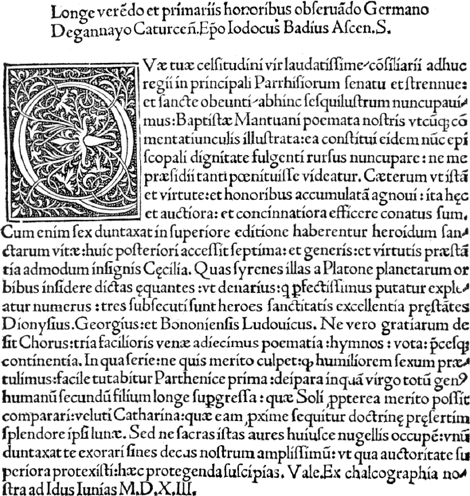 Fig. 3. The ‘Capsaca’ Great Primer [r 105] or Gros-romain (Venice, 1493; Paris, 1503) as it appears in B. Spagnuoli, Opera, Paris J. Badius, 1513, part i, f. a1v. Courtesy of the Stadsbibliotheek, Antwerp.
| |||||||||||||||||||||||||||||||||||||||||||||||||||||||||||||||||||||||||||||||||||||||||||||||||||||||||||||||||||||||||||||||||||||||||||||||||||||||||||||||||||||
[pagina 18]
| |||||||||||||||||||||||||||||||||||||||||||||||||||||||||||||||||||||||||||||||||||||||||||||||||||||||||||||||||||||||||||||||||||||||||||||||||||||||||||||||||||||
4. The ‘Capsaca’ Pica Roman [r 83] or Cicéro (Venice, 1493; Lyons, 1499; Paris, 1502)Carter (1969, 77, n. 3) has related this face to one of the several Pica Romans of Matteo Capsaca, who was active as a printer in Venice in the 1490s. It belongs to a group of Venetian Romans with distinctive stylistic characteristics departing from the usual Jenson model. The new style favoured thin hairline serifs to the heavier and bracketed ones of the earlier model. The design seems to originate at Benali's press at the end of the 1480s and was used either in different states or as close copies in Venice by H. Foxius [r 81], J. Rubeus Vercellensis [r 80], C. de Pentis [r 82], G. Ragazzo [r 82], M. Capsaca [r 84, r 81, r 80], and S. Bevilacqua [r 80b]. In Bologna, the presses of Ben. Hectoris [r 83] and Caligula de Bazaleriis [r 87] displayed the fount and in Milan those of U. Scinzenzeler [r 80] and L. Pachel [r 83]. Apart from Northern Italy, it enjoyed some distribution in France and Germany, probably one of the earliest Romans to do so. The identity of these founts, if confirmed, implies a trade of matrices beyond the regional boundaries from the late fifteenth century onwards (Johnson, 1943). In Lyons, the Capsaca r 81 version seems to have been used by Nicolas Wolf. He was registered in 1493 as ‘Nicolas Lupi, fondeur de lettres’ and is known to have had relations with Badius, prior to the latter's move to Paris (Catalogue BM, 8: lxvi-lxvii, pl. 54). In this type he printed Badius's 1499 edition of the Epistolae illustrium virorum (Catalogue BM, 8: 330). The Catalogue BM and Gültlingen (1992, 1: 95-100) report no further uses of this Roman in Wolf's subsequent production. The first Roman of Sebastian Gryphius may exhibit its capitals but the lower case is, though similar, not identical to this fount (Bertachini, 1525; Baudrier, 8: 41). In Paris, André Bocard was first to use it. His imprints display the fount only in 1502-1503 and 1517 (Renouard, 1964, 5: nos. 11, 13, 14, 48). Bocard's fifteenth-century type assortment consisted exclusively of Gothics. He began using Romans in 1501 with two Kerver founts (Renouard, 1964, 5: 9, no. 1 [state b] and pl. b iv 1) and the Bergmann and Tholoze Romans (see below 5 and 8). One is left wondering whether he owned this Capsaca fount or simply borrowed it from Badius, who showed this type from his first imprints dated 1503 onwards. The prefatory matter of the three items Bocard printed in 1502-1503 with this founts seem to imply some collaboration with Badius. Apart from its sporadic use by Bocard, Badius was the sole Paris printer to have it. It stayed in use till the end of the firm in 1536. In order to obtain a more open and lighter text page, Badius had it cast on the next bigger size of English (Saint-augustin) at the end of 1505. Size: Pica (Cicéro); 12/11 Anglo-American/Didot points; 20 83 × 2: 3 mm. | |||||||||||||||||||||||||||||||||||||||||||||||||||||||||||||||||||||||||||||||||||||||||||||||||||||||||||||||||||||||||||||||||||||||||||||||||||||||||||||||||||||
[pagina 19]
| |||||||||||||||||||||||||||||||||||||||||||||||||||||||||||||||||||||||||||||||||||||||||||||||||||||||||||||||||||||||||||||||||||||||||||||||||||||||||||||||||||||
The occurrence (as early as June 1503) of this face cast on that larger size as mentioned by Renouard (1964, 2: 28, no. 15) is moot. It probably refers to Wolf-Kerver's r 92 mentioned below in (6). Later Badius had some sorts changed (as the us-abbreviation and the position of the stroke on i but the exact date of that modification remains to be fixed). The fount remained quite popular in Italy and Germany in the early 1500s. With proper reserve, I think it may occur in Venice at the presses of J. de Pentis, S. Bevilacqua, S. de Luere, M. Sessa, M. de Bonellis (Isaac, 1938, 196-7), in Genoa, at that of P.P. Porro in his polyglott 1516 Psalterium (Isaac, 1938, 112). It may be the face which Martens and Sassenus used in Antwerp and Louvain from 1504 onwards (Nijhoff, 1926, 2: s.v). In Germany, the face seems to appear at Oeglin's press, Augsburg, from 1506 onwards (Proctor, 1903, 77 [type 2] and pl. 10). Johnson (1964, 232 and fig. 4) reports further uses in Cologne, Nuremberg, and Strasburg. An occurrence about 1500 in Vienna at the press of Joh. Winterburg needs closer examination (Catalogue BM, 3: 810). 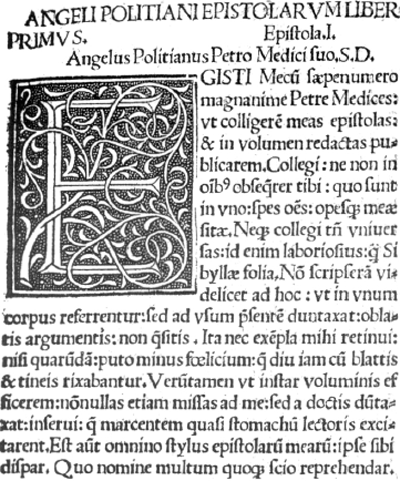 Fig. 4. The ‘Capsaca’ Pica [r 83] or Cicéro (Venice, 1493; Lyons, 1499; Paris, 1502) as it occurs in A. Poliziano, Opera, Paris, J. Badius, 1519, f. a1. Courtesy of the Stadsbibliotheek, Antwerp.
| |||||||||||||||||||||||||||||||||||||||||||||||||||||||||||||||||||||||||||||||||||||||||||||||||||||||||||||||||||||||||||||||||||||||||||||||||||||||||||||||||||||
[pagina 20]
| |||||||||||||||||||||||||||||||||||||||||||||||||||||||||||||||||||||||||||||||||||||||||||||||||||||||||||||||||||||||||||||||||||||||||||||||||||||||||||||||||||||
5. The ‘Bergmann’ Great Primer Roman [r 102] or Gros-romain (Basle, 1494; Paris, 1498)Johann Bergmann de Olpe, a Basle cleric and publisher of Sebastian Brant, patronized a printing press from 1494 onwards. His main text type was a newly made Great Primer 109 mm Roman (Catalogue BM, 3: 793). Johnson (1926, 7-8) suggested a Venetian origin, but its distribution rather points to Basle. Though less well designed than the contemporaneous Amerbach Roman on that size, it was one of the earliest Basle Romans to enjoy an international distribution in France, England, the Low Countries, Poland. It is a Roman of the Jenson family with the usual doubly-seriffed top of the M and e with tilted bar. Noticeable are its E with high middle arm, high stem of the G and the large upper bowl of the lower case g. In Paris it was the most popular Roman of the early sixteenth century in the range of Great Primer (110 mm) down to English (96 mm; as in Estienne's 1505 edition of the Hermes Trismegistus; Moreau, 1; 158, no. 82). The face was used from 1498 onwards by Levet, Le Noir, Tholoze (Catalogue BM, 8: 181; Renouard, 1964, 1: 105) and many others among whom Henry i Estienne, but not by Badius (except in the 1519 Athanasius which, however, was probably not printed by Badius) and the 1521 publications he issued with Jean Vatel. It stayed in use well into the 1520s and 1530s among others at the presses of Colines, Robert i Estienne, Tory. From 1519 onwards some Paris printers as La Barre, Vidoue, Gromors and in the 1530s Tory used the variant state with a flattened bar in e and a small-bowled g. Both sorts may have been cut by or to the directives of Jean Vatel, who seems to have collaborated with La Barre and to have been responding to the newer ideas about the ideal letterforms of Roman letters. See below (25). In Great Britain Pynson from 1508 onwards and many subsequent London printers up to the end of the century were among its users (Isaac, 1933, 88; 1936, 5; Johnson, 1936, 71-3; Reed, 1952, 86). De Worde, Redman, Berthelet had the state with the variant lower case e and g. In the Low Countries it was used by Thibault with some divergent or poorly cast sorts (Vervliet, 1968, 256); in Poland by J. Clymes (Isaac, 1938, 240). Size: Large English/Great Primer (Gros-texte/Gros-romain); 14.5/13.5 Anglo-American/Didot points; 20 102 × 2: 3.6 mm. | |||||||||||||||||||||||||||||||||||||||||||||||||||||||||||||||||||||||||||||||||||||||||||||||||||||||||||||||||||||||||||||||||||||||||||||||||||||||||||||||||||||
[pagina 21]
| |||||||||||||||||||||||||||||||||||||||||||||||||||||||||||||||||||||||||||||||||||||||||||||||||||||||||||||||||||||||||||||||||||||||||||||||||||||||||||||||||||||
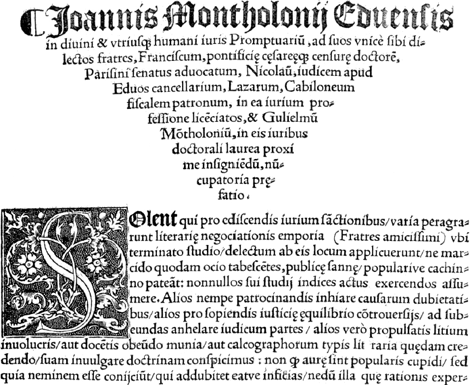 Fig. 5. The ‘Bergmann’ Great Primer [r 102] or Gros-romain (Basle, 1494; Paris, 1498) as it appears in J. de Montholon, Promptuarium, Paris, S. de Colines, 1520, vol. 1, f. 2. Courtesy of the Stadsbibliotheek, Antwerp.
| |||||||||||||||||||||||||||||||||||||||||||||||||||||||||||||||||||||||||||||||||||||||||||||||||||||||||||||||||||||||||||||||||||||||||||||||||||||||||||||||||||||
[pagina 22]
| |||||||||||||||||||||||||||||||||||||||||||||||||||||||||||||||||||||||||||||||||||||||||||||||||||||||||||||||||||||||||||||||||||||||||||||||||||||||||||||||||||||
6. The ‘Wolf-Kerver’ English-bodied Roman [r 92] or Saint-augustin (1494)Wolf, Jean Philippi and Kerver used consistently two Romans [r 92 and r 79] of which this is the larger one; both are stylistically related and may originate from the same source, perhaps Wolf; see the Catalogue BM (8: 214). The same catalogue (8: 144) points to the similarity of some capitals with those of Gering's Large English (above 1). Kerver used these founts when in 1503 he introduced the use of Roman in Paris printed Hours. Normally and far into the sixteenth century these prayer books were set in Gothic type (Vervliet, 2004a). Later, Paris printers or publishers used this face occasionally. It must not be excluded that Nicolas Desprez owned a set of matrices. He used this face until 1520 when he changed over to the fount described below in (20). Desprez was originally from Troyes which may link him to Guillaume Le Rouge (12) and lead to the hypothesis of a Le Rouge-Desprez typefoundry in Paris. Badius seems to have used this fount once at the very beginning of his printing career, e.g. in the Bibliothèque nationale copy of Spagnuoli's Bucolica (Moreau, 1: 88, no. 119; BNF, Rés. myc 691:1) but probably that issue (or its first quire) was printed by Bocard. Size: English (Saint-augustin); 13/12 Anglo-American/Didot points; 20 92 × 2.2:3.2 mm. 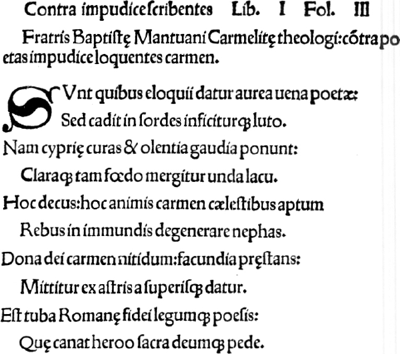 Fig. 6. Wolf-Kerver's English-bodied Roman [r 92] or Saint-augustin (1494) as it appears in B. Spagnuoli, Contra poetas impudice loquentes, Paris, G. Wolf and Th. i Kerver for H. de Coblencz & J. Petit, 1499, f. Aa3. Courtesy of the University Library, Ghent.
| |||||||||||||||||||||||||||||||||||||||||||||||||||||||||||||||||||||||||||||||||||||||||||||||||||||||||||||||||||||||||||||||||||||||||||||||||||||||||||||||||||||
[pagina 23]
| |||||||||||||||||||||||||||||||||||||||||||||||||||||||||||||||||||||||||||||||||||||||||||||||||||||||||||||||||||||||||||||||||||||||||||||||||||||||||||||||||||||
7. The ‘Kerver’ Pica Roman [r 79] or Cicéro (1498)This face may have been intended as a smaller-sized companion face to the Wolf-Kerver Roman on English (6). Except for the capital A most letterforms are stylistically similar. Probably it was engraved by the same letter engraver. Noteworthy are its occurrence at the press of Guillaume Le Rouge, on which see below (12), and the fact that its capitals are all but identical with those of Kerver's 1516 Italic (Vervliet, 2005, no. 6). Kerver used this face for his Hours set in Roman (Vervliet, 2004a). Size: Pica (Cicéro); 11/10.5 Anglo-American/Didot points; 20 79 × 1.6:2.5 mm. 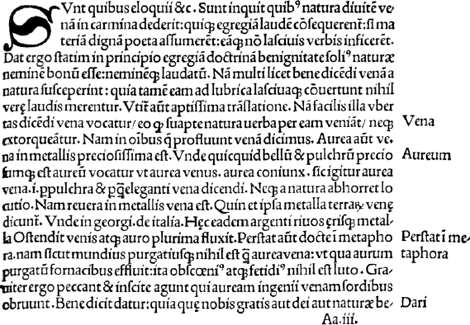 Fig. 7. The ‘Kerver’ Pica [r 79] or Cicéro (1498) as it appears in B. Spagnuoli, Contra poetas impudice loquentes, Paris, G. Wolf and Th. i Kerver for H. de Coblencz & J. Petit, 1499, f. Aa3. Courtesy of the University Library, Ghent.
| |||||||||||||||||||||||||||||||||||||||||||||||||||||||||||||||||||||||||||||||||||||||||||||||||||||||||||||||||||||||||||||||||||||||||||||||||||||||||||||||||||||
[pagina 24]
| |||||||||||||||||||||||||||||||||||||||||||||||||||||||||||||||||||||||||||||||||||||||||||||||||||||||||||||||||||||||||||||||||||||||||||||||||||||||||||||||||||||
8. The ‘Tholoze’ Pica Roman [r 78] or Cicéro (1499)This 78 mm Pica originated in Paris occurring from 1499 onwards at the press of Tholoze, later at those of Le Noir, Levet, Baligault, Gaspar Philippe (Catalogue BM, 8: 169). In this body size it became the usual Roman of Paris printers (including Henry i Estienne and Badius) for the next four decades of the century. Colines used it until 1526 but other Paris printers put it to use until well in the 1530s. It is the text type of Tory's Champfleury (1529) and it appears in a freshly cast fount as late as 1538 at the press of Regnault. It was used by several printers in the Low Countries and in England by Wynkyn de Worde and many other London printers (Johnson, 1936, 72). In its category and for its time it is a good and well balanced design. Though I do not know by whom, it was probably engraved in Paris. A set of matrices for a ‘glause romyn’ mentioned in the estate of Wolfgang Hopyl (1523) may stand for this type (Stein, 1905, 182). A number of Roman capitals of this face occur in Gourmont's Greek of 1507 coupled to new Greek capitals, which were fittingly cut in the same style as the Roman ones and, probably, by the same punchcutter in Paris. Indirectly this is confirmed by the reports of both Gourmont's editors, François Tissard in 1507 and Girolamo Aleandro in 1508, that the Greek type was locally made (Omont, 1891, 47 and 69; Vervliet, 2002, 7-9). Size: Pica (Cicéro); 10.5/10 Anglo- American/Didot points; 20 78 × 1.7:2.5 mm. | |||||||||||||||||||||||||||||||||||||||||||||||||||||||||||||||||||||||||||||||||||||||||||||||||||||||||||||||||||||||||||||||||||||||||||||||||||||||||||||||||||||
[pagina 25]
| |||||||||||||||||||||||||||||||||||||||||||||||||||||||||||||||||||||||||||||||||||||||||||||||||||||||||||||||||||||||||||||||||||||||||||||||||||||||||||||||||||||
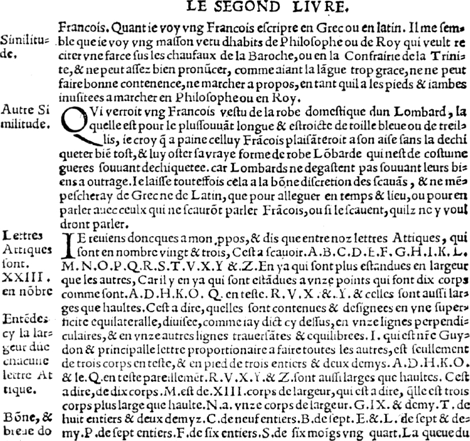 Fig. 8. The ‘Tholoze’ Pica [r 78] or Cicéro (1499) as it occurs in G. Tory, Champfleury, Paris, G. Tory & G. de Gourmont, 1529, f. xii v. Courtesy of the Royal Library, Brussels.
| |||||||||||||||||||||||||||||||||||||||||||||||||||||||||||||||||||||||||||||||||||||||||||||||||||||||||||||||||||||||||||||||||||||||||||||||||||||||||||||||||||||
[pagina 26]
| |||||||||||||||||||||||||||||||||||||||||||||||||||||||||||||||||||||||||||||||||||||||||||||||||||||||||||||||||||||||||||||||||||||||||||||||||||||||||||||||||||||
9. The ‘Quentel’ Roman Small Pica Roman [r 72] or Philosophie (Cologne, 1499; Paris, 1521)In Paris I have seen this face only occurring at Vidoue's press from 1521 onwards. I suppose it was imported from Germany. Ostensibly it was part of German typographical, decorative and illustrative materials which, mostly in collaboration with Conrad Resch, Vidoue started to use from the early 1520s onwards. It seems to originate in 1499 at Quentel's press, Cologne. A close copy occurs at Johann Schoeffer's press in Mainz from 1518 onwards (Proctor, 1903, 18 [type 16]; Johnson, 1943, 53). Size: Small Pica (Philosophie); 11/10 Anglo-American/Didot points; 20 72 × 1.5: 2.5 mm.  Fig. 9. The ‘Quentel’ Small Pica [r 72] or Philosophie (Cologne, 1499; Paris, Vidoue, 1521) as it appears in J. Lefèvre d'Etaples, In quoscunque Philosophiae... Paraphrasis, Paris, P. Vidoue & F. Regnault, 1525, f. b3. Courtesy of the University Library, Ghent.
| |||||||||||||||||||||||||||||||||||||||||||||||||||||||||||||||||||||||||||||||||||||||||||||||||||||||||||||||||||||||||||||||||||||||||||||||||||||||||||||||||||||
[pagina 27]
| |||||||||||||||||||||||||||||||||||||||||||||||||||||||||||||||||||||||||||||||||||||||||||||||||||||||||||||||||||||||||||||||||||||||||||||||||||||||||||||||||||||
10. The ‘Hopyl’ English-bodied Roman [r 98] or Saint-augustin (1508)Up to 1507 Wolfgang Hopyl's first Roman face in a text size was the popular Bergmann Great Primer, described above in (5). Thereafter and up to the 1520s, as in his Cyrillus editions of 1508, 1514 and 1521 (Moreau, 1: 273, no. 59; 2: 244, nos. 812-3; 3: 69, no. 76), he used this face which appears to have been proprietary to him. The set of matrices for a ‘texte romyn’ mentioned in his estate (1523) is almost certainly for this type (Stein, 1905, 182). Size: English (Saint-augustin); 14/13 Anglo-American/Didot points; 20 99 × 2: 3.2 mm. 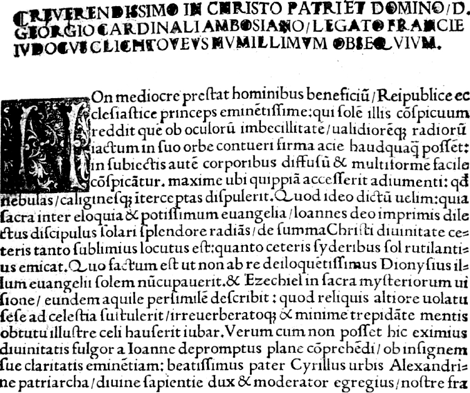 Fig. 10. The ‘Hopyl’ English-bodied Roman [r 99] or Saint-augustin (1508) as it appears in Cyrillus Alexandrinus, Opus insigne... in euangelium Ioannis, Paris, W. Hopyl, 1508, f. a2. Courtesy of the Bibliothèque Mazarine, Paris.
| |||||||||||||||||||||||||||||||||||||||||||||||||||||||||||||||||||||||||||||||||||||||||||||||||||||||||||||||||||||||||||||||||||||||||||||||||||||||||||||||||||||
[pagina 28]
| |||||||||||||||||||||||||||||||||||||||||||||||||||||||||||||||||||||||||||||||||||||||||||||||||||||||||||||||||||||||||||||||||||||||||||||||||||||||||||||||||||||
11. The ‘Badius’ Long Primer Roman [r 67] or Petit-romain (1509)A small-sized Roman, clearly proprietary to Badius, was used from 1509 onwards. The reference by Renouard (1964, 2: 38, no. 41) to an r 64 occurring as early as 1505 in Badius's Plutarchus is probably a misprint for r 77; in all likelihood, this is the fount described above in (8). The capitals of the r 67 seem to recall the hand of the Tholoze cutter (8), but it is hazardous to judge on style alone. I have not seen this face used outside the Badius press. Size: Long Primer Roman (Petitromain); 9/8.5 Anglo-American/Didot points; 20 67 × 1.5: 2.2 mm. 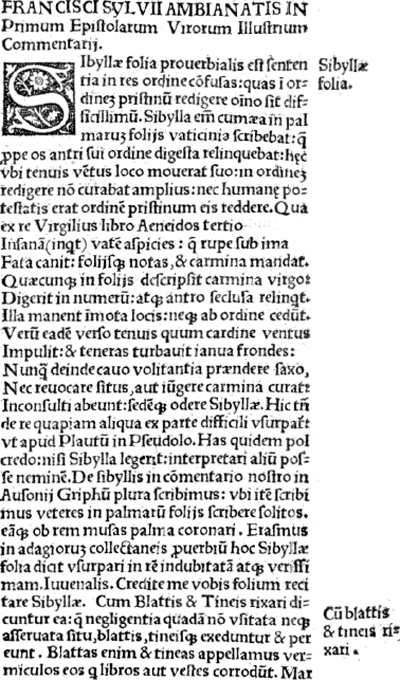 Fig. 11. The ‘Badius’ Long Primer [r 67] or Petit-romain (1509) as it appears in A. Poliziano, Opera, Paris, J. Badius, 1519, f. a1. Courtesy of the Stadsbibliotheek, Antwerp.
| |||||||||||||||||||||||||||||||||||||||||||||||||||||||||||||||||||||||||||||||||||||||||||||||||||||||||||||||||||||||||||||||||||||||||||||||||||||||||||||||||||||
[pagina 29]
| |||||||||||||||||||||||||||||||||||||||||||||||||||||||||||||||||||||||||||||||||||||||||||||||||||||||||||||||||||||||||||||||||||||||||||||||||||||||||||||||||||||
12. The ‘Le Rouge’ Long Primer Roman [r 67] or Petit-romain (1513)In 1513 Le Rouge matched the upright capitals of his 1512 Pica Italic (Vervliet, 2005, no. 2) to a new small lower case Roman, yielding a new fount in the size of Long Primer. Ostensibly the fount appeared already in 1510 in some copies of a Berosus edition with an imprint of Geoffroy de Marnef (Moreau, 1: 352, no. 27). Such an early date, however, is questionable as this Roman seems only to occur in some copies of that item, which constitute a later augmented edition (Bernard, 1865, 97; unmentioned by Moreau). The same is probably the case for the Epistole Francisci Nigri, published by Roce and Le Rouge and dated c.1510 by Monceaux (1896, 402-3). Size: Long Primer Roman (Petit-romain); 9/8.5 Anglo-American/Didot points; 20 67 × 1.5: 2.4 mm. 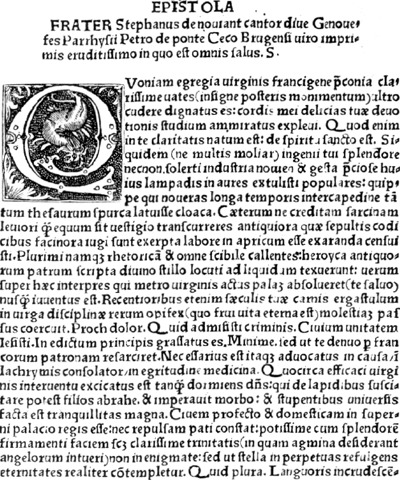 Fig. 12. The ‘Le Rouge’ Long Primer [r 67] or Petit-romain (1513) as it occurs in P. de Ponte, Incomparanda Genouefeum, Paris, G. Le Rouge for D. Roce, 1513, f. a2v. Courtesy of the Royal Library, The Hague.
| |||||||||||||||||||||||||||||||||||||||||||||||||||||||||||||||||||||||||||||||||||||||||||||||||||||||||||||||||||||||||||||||||||||||||||||||||||||||||||||||||||||
[pagina 30]
| |||||||||||||||||||||||||||||||||||||||||||||||||||||||||||||||||||||||||||||||||||||||||||||||||||||||||||||||||||||||||||||||||||||||||||||||||||||||||||||||||||||
Le Rouge seems to mention this new Roman fount in the colophon of the second volume (f. 04v) of his 1513-14 edition of Dati's Orationes (Moreau, 2: nos. 557 and 815); that work is described as being issued in ‘Parisius oîa caractere Cesareo excusa... in officina Guillelmi Le Rouge’ (Printed in Paris at the press of Guillaume Le Rouge wholly with Caesar's types). What he meant by that expression is something of a riddle. Obviously Le Rouge wished to call attention to the types and so the term does not simply stand for ‘In praelo Cesareo’, which was the address of Robert Caesar and Georges Biermant. If it is a reference to the types, is it a reference to Petrus Caesaris and Russangis, who printed in Paris in the 1470s (Catalogue BM, 8: 9-14; Veyrin-Forrer, 1987, 222) and were mentioned above in (1)? Petrus Caesaris died in 1509 and was temporarily succeeded in Paris by Robert Caesar or De Keysere, before the latter's move to Ghent in 1513 (Renouard, 1965, 63-4); however, Robert or his associate Georges Biermant never used this type (Renouard, 1964, 3: 508; 1965, 34, 64). Or could it be a reference to Nicolaus or Konrad Caesar, who were printing in Cologne at the end of the 1510s, though none of their founts occurred in Paris? Or was Martinus Caesar, vulgo Martin Lempereur or Marten de Keyser, meant, who later printed in Antwerp, being married to a Françoise La Rouge (Vervliet, 1968, 23; Chambers, 1983, 118-9) and owning the decorated capitals of Le Rouge's Great Primer cursive, described above in (1)? Or was yet another fount intended? Le Rouge apparently did not introduce new types before 1512/3 and doubt is allowed whether he himself was a letter engraver. A possible role of Martinus Caesar, who is thought to be a son of Pierre and son-in-law of Le Rouge (Monceaux, 1896, 274; Rouzet, 1975, 113), is conceivable. The problem here is that we do not know what were Martinus's activities between, say, the death of Guillaume Le Rouge (1517) and Martinus's First Antwerp publication (1525). To be sure, he introduced some Paris Romans (33, 40) and an Italic (Vervliet, 2005, no. 9) in Antwerp. | |||||||||||||||||||||||||||||||||||||||||||||||||||||||||||||||||||||||||||||||||||||||||||||||||||||||||||||||||||||||||||||||||||||||||||||||||||||||||||||||||||||
[pagina 31]
| |||||||||||||||||||||||||||||||||||||||||||||||||||||||||||||||||||||||||||||||||||||||||||||||||||||||||||||||||||||||||||||||||||||||||||||||||||||||||||||||||||||
13. The ‘Ruel’ Great Primer Roman [r 117] or Gros-romain (1516)This is a peculiar Roman, to the best of my knowledge appearing only in four publications, one by Henry i Estienne (1516), one by Guillaume Le Rouge (1517), two by Didier Maheu (1519). All four titles share a medical subject: Dioscorides (1516) and three Galenus editions (1517-19). The Dioscorides was translated and edited by Jean Ruel (or Du Rueil); two of the Galenus editions were translated and edited by Thomas Linacre (Moreau, 2: nos. 1334, 1615, 2060-1). They are part of the Paris mid-1510s effort to surpass Venice in the field of medical publishing (Durling, 1961, 252). Instrumental were the physicians Cop, Ruel, Linacre and the humanists Budé and Lupset. The latter happened to stay in Paris during those years; with Budé he supervised the printing of Linacre's 1517 Galenus translation (Maddison, 1977, xxxvi, n. 24). Moreover Budé wrote a prefatory letter for Linacre's edition of Galenus's 1519 De sanitate tuenda. Linacre on his part had visited Paris in 1514 as the physician of Mary Tudor during the few months she was compelled to be the bride of a moribund Louis xii (†1515). The forthcoming publication of the 1516 Dioscorides was announced in a letter from Badius to Erasmus of 19 August 1515: ‘Budaeus opus de Asse relambit. A Ruella Dioscoriden impressioni aptat’ (Allen, 2:125, no. 34611).Ga naar voetnoot6 The actual printing of the Dioscorides was not entrusted to Badius, but to Henry i Estienne, possibly because the latter had a better record in medical publishing. It was Estienne's sole work set in this fount. In 1517 the face reappeared at the press of Le Rouge (with an imprint of the Marnefs) in Linacre's translation of Galenus's De sanitate tuenda (Moreau, 2:430, no. 1615). Clearly, the move to a new press was friendly, as Le Rouge was allowed to use Estienne's latest title-border ‘aux armes de Paris’, albeit with appropriatedly changed typeset words inserted into the woodcut. Estienne had three titleborders with the arms of Paris, datable to 1506, 1509 and 1513/14 onwards (reproduced by Mortimer, 1964, 2: nos. 217, 329, 322). The title-border was returned and used again at Estienne's press from 1518 onwards (Moreau, 2: nos. 1824, 1961). This is the sole use of the titleborder and this Roman by Le Rouge, but he had access to a new Greek, ostensibly cut by the same engraver. After Le Rouge's death in 1517, the fount was passed on to Maheu for the two last works known to have been printed in this face, viz. Galenus's De differentiis febrium and Methodus medendi (1519). The last title was edited by Linacre (Moreau, 2:530, nos. 2060-1). Size: Great Primer (Gros-romain); 14.5/13.5 Anglo-American/Didot points; 20 117 × 2.5:4 mm. | |||||||||||||||||||||||||||||||||||||||||||||||||||||||||||||||||||||||||||||||||||||||||||||||||||||||||||||||||||||||||||||||||||||||||||||||||||||||||||||||||||||
[pagina 32]
| |||||||||||||||||||||||||||||||||||||||||||||||||||||||||||||||||||||||||||||||||||||||||||||||||||||||||||||||||||||||||||||||||||||||||||||||||||||||||||||||||||||
Hereafter the fount disappears, Anyhow it was not listed in Maheu's inventory of 1520 (Coyecque, 1894, 204) and no further occurrences are known: no doubt, an indication that it was not in the hands of a professional printer or publisher. I am tempted to think that the type was engraved on behalf of one of the two French humanists involved in this publication program. Budé participated in at least three of the four publications and it could be envisaged that he was the driving force in this scheme. On the other hand, Ruel should not be ruled out because of the materia medica which, apart from this new fount, is the common element in the four titles. Jean Ruel (†1537), then professor of medicine at the Paris Faculty of Medicine and later physician to Francis i (Jourdan, 1918, 175-7; Delaruelle, 1922, 55-6; Deronne, 1971, 16; Wickersheimer, 1979, 1; 395-6) was a renowned scholar honoured by his humanist colleagues for his knowledge of the ancient Greek medical literature. Later Erasmus (1969, 12: 675) was to cite him in his Ciceronianus as ‘peritissimus rei medicae in vertendis Graecis religiosae fidei’.Ga naar voetnoot7 Clearly Ruel had a taste for fine books: his Veterinariae medicinae libri ii (1530) and De natura stirpium (1536), both dedicated to Francis i, are among the finest produced by the Blaubloom and Colines presses (Mortimer, 1964, 581-3, nos. 470-1), while three copies now in the British Library of the 1517-9 Galenuses printed in this face are preserved in Renaissance bookbindings. They were offered by Linacre to Henry viii and Cardinal Thomas Wolsey. They belong to a group of early gold-tooled bindings and are thought to originate from the first Renaissance bookbinders shop in Paris (Nixon, 1956, 34; 1971, 9-12; Guignard, 1966, 238; Barber, 2000, 58). No doubt, Linacre and Lupset when in Paris were allowed into the inner circle of Budé and Ruel (Delaruelle, 1907, 27, n. 3).Ga naar voetnoot8 It is unclear to me why Ruel, if he rather than Budé was patronizing this novel fount, had this type engraved and did not use the Bergmann Great Primer Roman described above in (5) that was Estienne's usual face in this size. Budé seems to have been less exacting: for his own publications he was happy with the old founts currently available at Badius's press, which was and stayed his preferred publishing firm. If my hypothesis of a patronage by Ruel is right, it may constitute one of the earliest involvements of a Paris scholar in the creation of a private type, echoing the venture of Guillaume Fichet and Johann Heynlin in Paris of the 1470s. Mainly because the time frame is right, Amert (2001, 24) has suggested that this face may be an early work of a novice Simon de Colines. Three points seem to contradict this hypothesis. The first is the | |||||||||||||||||||||||||||||||||||||||||||||||||||||||||||||||||||||||||||||||||||||||||||||||||||||||||||||||||||||||||||||||||||||||||||||||||||||||||||||||||||||
[pagina 33]
| |||||||||||||||||||||||||||||||||||||||||||||||||||||||||||||||||||||||||||||||||||||||||||||||||||||||||||||||||||||||||||||||||||||||||||||||||||||||||||||||||||||
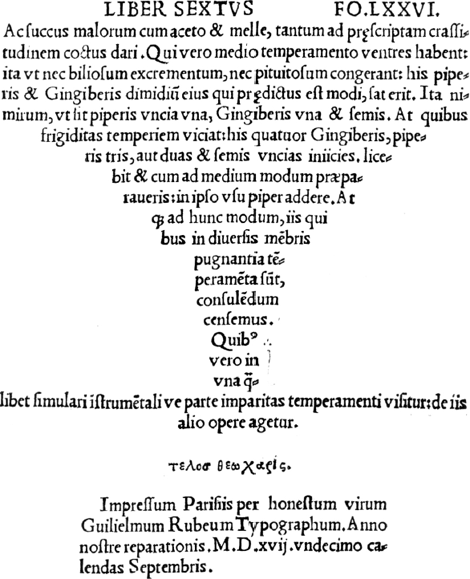 Fig. 13. The ‘Ruel’ Great Primer [r 117] or Gros-romain (1516) as it appears in Galenus,
De sanitate tuenda, Paris, G. Le Rouge, 1517, f. 76. Courtesy of the University Library, Utrecht. | |||||||||||||||||||||||||||||||||||||||||||||||||||||||||||||||||||||||||||||||||||||||||||||||||||||||||||||||||||||||||||||||||||||||||||||||||||||||||||||||||||||
[pagina 34]
| |||||||||||||||||||||||||||||||||||||||||||||||||||||||||||||||||||||||||||||||||||||||||||||||||||||||||||||||||||||||||||||||||||||||||||||||||||||||||||||||||||||
incongruity of the letterforms with those we can observe in the other early work arguably of Colines. Second, the reappearances of the fount at other presses - a practice which Colines avoided. Third, the fount does not appear in any of the later imprints of Henry 1 Estienne or Simon de Colines (Vervliet, 2002a, 274). Some letterforms, as the capital N and the lower case g, recall those of the Le Rouge Long Primer, described above in (8), and this type may have the same origin. | |||||||||||||||||||||||||||||||||||||||||||||||||||||||||||||||||||||||||||||||||||||||||||||||||||||||||||||||||||||||||||||||||||||||||||||||||||||||||||||||||||||
14. The ‘Cervicornus’ English-sized Roman [r 88] or Saint-augustin (Cologne, 1517; Paris, 1522)This face is the third in a family of English-sized Romans whose letterforms point to a common source. As a family it appears at German presses, including Strasburg and Basle, in the last decade of the fifteenth century, afterwards spreading all over Europe. It deserves more research to ascertain whether the three founts came from different sets of punches or originated from one set with only some sorts replaced. The youngest version of this letter family dates from 1517; its spot letter is the capital M, with a centre down to the base line. The typeface was probably cut by Peter ii Schoeffer, in whose publications the earlier versions appear, while the third version appears at the press of Thomas Platter, whose autobiography reports him buying founts from Schoeffer. In Paris, it has only been seen at the press of Pierre Vidoue, who was using it well into the 1540s. Nevertheless it is tempting to assume that it was part of a new wave of imported German founts which comprised not only Romans but also Italic and Greek typefaces and occurred in the early 1520s (Vervliet, 2002, 10-12; 2005, Fig. 15d). Conrad Resch is cited as the broker with access to Basle types, borders, initials (Johnson, 1927, 355-6; Bietenholz, 1971, 33-4). Size: English (Saint-augustin); 12.5/11.5 Anglo-American/Didot points; 20 88 × 1.9: 3 mm. | |||||||||||||||||||||||||||||||||||||||||||||||||||||||||||||||||||||||||||||||||||||||||||||||||||||||||||||||||||||||||||||||||||||||||||||||||||||||||||||||||||||
[pagina 35]
| |||||||||||||||||||||||||||||||||||||||||||||||||||||||||||||||||||||||||||||||||||||||||||||||||||||||||||||||||||||||||||||||||||||||||||||||||||||||||||||||||||||
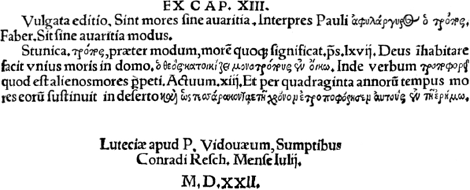 Fig. 14. The ‘Cervicornus’ English-sized Roman [r 88] or Saint-augustin (Cologne, 1517; Paris, 1522) as it appears in J. Lopez de Zuniga, Annotationes contra lacobum Fabrum, Paris, P. Vidoue for C. Resch, 1522, f. dd6. Courtesy of the Bibliothèque municipale, Le Mans.
| |||||||||||||||||||||||||||||||||||||||||||||||||||||||||||||||||||||||||||||||||||||||||||||||||||||||||||||||||||||||||||||||||||||||||||||||||||||||||||||||||||||
[pagina 36]
| |||||||||||||||||||||||||||||||||||||||||||||||||||||||||||||||||||||||||||||||||||||||||||||||||||||||||||||||||||||||||||||||||||||||||||||||||||||||||||||||||||||
15. Colines's Roman titling on Two-line English [r 9.5] or Deux points de Saint-augustin (1518)This titling is attributed to Colines because it appeared first at the press of Henri i Estienne and thereafter at that of Colines. It was probably Colines's first typeface (Vervliet, 2003). With the 1519 Desprez titling (16) on the same size it is an answer to a well-designed and popular 8.2 mm Roman titling, appearing in 1517 at the Froben press in Basle and probably cut by Peter ii Schoeffer. The Colines fount has been reviewed by Vervliet (2003, 123). Size: Two-line English (Deux points de Saint-augustin); 26.5/25 Anglo-American/Didot points;: 9.5 mm.  Fig. 15a. Colines's titling on Two-line Great Primer [r 9.5] or Deux points de Saint-augustin (1518) as it appears on the title-page of the second volume of J. de Montholon, Promptuarium, Paris, Colines, 1520. Courtesy of the Stadsbibliotheek, Antwerp.
 Fig. 15b. Colines's titling on Two-line Great Primer [r 9.5] or Deux points de Saint-augustin (1518) assembled from J. de Montholon, Promptuarium, Paris, Colines, 1520. Courtesy of the Stadsbibliotheek, Antwerp.
| |||||||||||||||||||||||||||||||||||||||||||||||||||||||||||||||||||||||||||||||||||||||||||||||||||||||||||||||||||||||||||||||||||||||||||||||||||||||||||||||||||||
[pagina 37]
| |||||||||||||||||||||||||||||||||||||||||||||||||||||||||||||||||||||||||||||||||||||||||||||||||||||||||||||||||||||||||||||||||||||||||||||||||||||||||||||||||||||
16. The ‘Desprez’ Roman titling on Two-line Pica [r 8.5] or Deux points de Cicéro (1519)As the Colines titling described above (15), this face is a hopelessly rough imitation of a Basle fount, a painful illustration of Parisian backwardness in this time compared to Italy or Basle. The Basle design appeared at Froben's press in 1517, became very popular, and was on sale until well in the eighteenth century. It was the first in a coherent family of four typesizes. From 1518 onwards titlings on 14.5, 6 and 4 mm were to follow. It is generally (and plausibly) attributed to Peter ii Schoeffer (Carter, 1969, 110-11). The first occurrence of the Paris fount is in the 1519 Nonius Marcellus. That publication is attributed by Moreau (2: 553, no. 2160) to the press of Nicolas Desprez because of the use of one of his titleborders. Earlier occurrences of this face such as in Jean ii de Marnef's Du Coste of c. 1518 (Moreau, 2: 473, no. 1808) are dated tentatively. In the 1520s the Paris imitation was widely adopted by most Paris printers though not by the Estienne-Colines group, which continued to make use of their own Colines titling (15) on this size, nor by Wechel who began using the genuine Basle titling from 1530 onwards. Afterwards the qualitatively superior Basle titling drove out the imitations, not only in Paris but throughout Europe. It remained on the market into well in the eighteenth century (Mori, 1924, pl. 5, line 5, with some divergent sorts). Another titling on the same size, much better designed than the Desprez one, appears on the title-page of Petit's 1518/9 Athanasius. As its printer or printers Badius or Aussourd have been suggested (Moreau, 2: 512, no. 1982; Renouard, 1964, 2: 171, no. 396). Apparently two printshops were involved, none of which used types of Badius's assortment. Its first title-line is a well-designed titling which shows a good understanding of the Roman classical capital. Some three years before Tory's return from Rome this comes as a surprise. However, small differences in a couple of letters occurring more than once may induce one to think that the title-line was woodcut. Anyhow, so far as I known, the design was afterwards not used again. It is difficult to be firm about its designer or woodcutter but Jean Vatel is certainly among the candidates. In his later publications elegant open and wholly unadorned Roman and Greeks inscriptional capitals appear - the earliest in Paris to have such ones. Vatel may also have had a hand in the pseudo-Basle capitals - probably again woodcut - appearing on the title-page of the 1522 Vacet edition by La Barre and Vatel (Moreau, 3: no. 407). For another woodcut title, see below (36). Size: Two-line Pica (Deux points de Cicéro); 27/24 Anglo-American/Didot points;: 8.5 mm. | |||||||||||||||||||||||||||||||||||||||||||||||||||||||||||||||||||||||||||||||||||||||||||||||||||||||||||||||||||||||||||||||||||||||||||||||||||||||||||||||||||||
[pagina 38]
| |||||||||||||||||||||||||||||||||||||||||||||||||||||||||||||||||||||||||||||||||||||||||||||||||||||||||||||||||||||||||||||||||||||||||||||||||||||||||||||||||||||
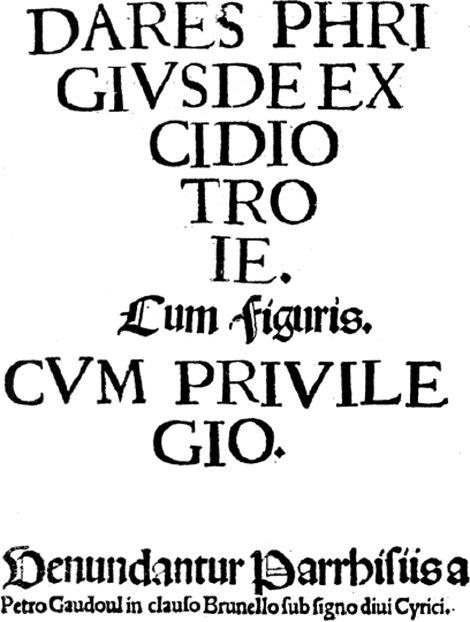 Fig. 16a. The ‘Desprez’ titling on Two-line English [r 8.5] or Deux points de Saint-augustin (1519) as it appears on the title-page of Dares Phrygius, De excidio Troie, Paris, N. Desprez for P. Gaudoul, 1520. Courtesy of the Royal Library, The Hague.
| |||||||||||||||||||||||||||||||||||||||||||||||||||||||||||||||||||||||||||||||||||||||||||||||||||||||||||||||||||||||||||||||||||||||||||||||||||||||||||||||||||||
[pagina 39]
| |||||||||||||||||||||||||||||||||||||||||||||||||||||||||||||||||||||||||||||||||||||||||||||||||||||||||||||||||||||||||||||||||||||||||||||||||||||||||||||||||||||
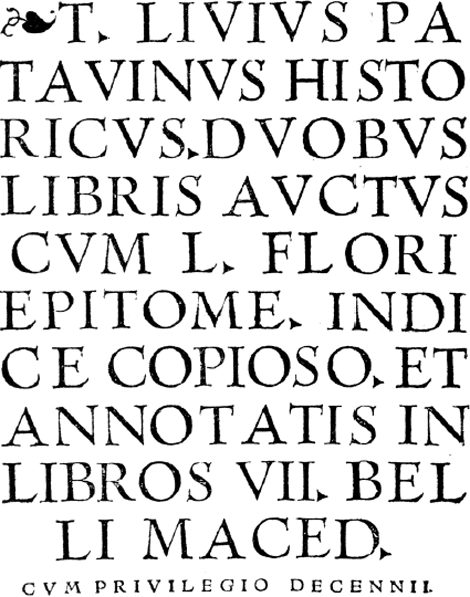 Fig. 16b. The Schoeffer titling on Two-line [r 8.5] or Deux points de Saint-augustin (1517) as it appears on the title-page of T. Livivs Patavinvs historicvs dvobvs libris avctvs, Mainz, J. Schoeffer, 1518. Courtesy of the University Library, Ghent.
| |||||||||||||||||||||||||||||||||||||||||||||||||||||||||||||||||||||||||||||||||||||||||||||||||||||||||||||||||||||||||||||||||||||||||||||||||||||||||||||||||||||
[pagina 40]
| |||||||||||||||||||||||||||||||||||||||||||||||||||||||||||||||||||||||||||||||||||||||||||||||||||||||||||||||||||||||||||||||||||||||||||||||||||||||||||||||||||||
17. Colines's first English-bodied Roman [r 90] or Saint-augustin (1519)This fount is a close copy on reduced body of the Bergmann Great Primer (5) used regularly by Henry i Estienne. It exists in three states, the later ones being introduced in 1520 and 1522. The Colines fount has been reviewed by Vervliet (2003, 124-5). Size: English (Saint-augustin); 13/12 Anglo-American/Didot points; 20 90 × 2: 3 mm. 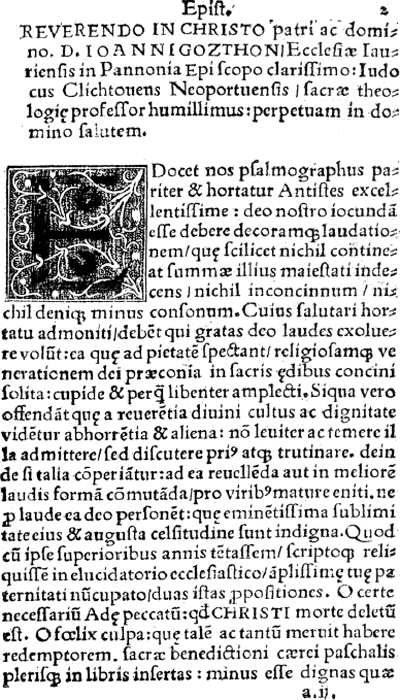 Fig. 17. Colines's English-bodied roman or Saint-augustin (1519) as it appears in J. Clichtove, De necessitate peccatae Adae, Paris, Henry i Estienne, 1519, f. a2. The small capital Z in the 3rd line is a wrong sort. Courtesy of the University Library, Ghent.
| |||||||||||||||||||||||||||||||||||||||||||||||||||||||||||||||||||||||||||||||||||||||||||||||||||||||||||||||||||||||||||||||||||||||||||||||||||||||||||||||||||||
[pagina 41]
| |||||||||||||||||||||||||||||||||||||||||||||||||||||||||||||||||||||||||||||||||||||||||||||||||||||||||||||||||||||||||||||||||||||||||||||||||||||||||||||||||||||
18. The ‘Lotter’ Long Primer Roman [R 66] or Petit-romain (Leipzig, 1519; Paris, 1526)This Long Primer appears from 1526 onwards in a limited number of Parisian imprints, which Moreau assigns to the press of Gromors. Only the 1527 Cato (Moreau, 3:390, no. 1400) shows Gromors's name, albeit as a bookseller. Anyhow, this fount smells of some foreign, presumably German, origin. Earlier German Romans in this size date from the end of the fifteenth century, e.g. at the presses of Froben, Quentel or Cervicornus; they are similar, not identical. But the 1519 Lotter Roman as well as later German founts in this class seem identical to the Paris face, except for some odd sorts (such as the pointed capital A) which the Paris printer mixed into his case. Size: Long Primer (Petit-romain); 9.5/9 Anglo-American/Didot points; 20 66 × 1.5: 2.3 mm. 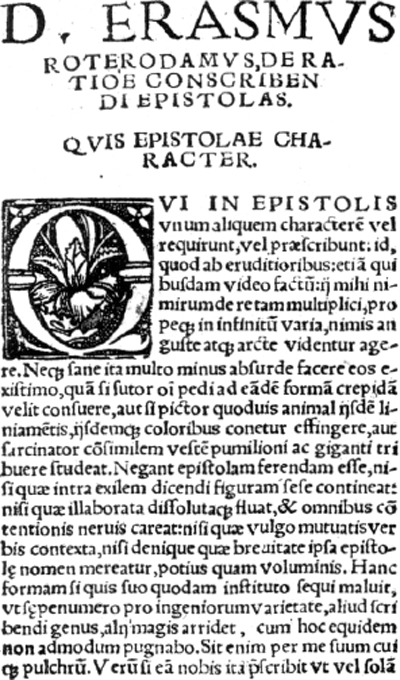 Fig. 18. The ‘Lotter’ Long Primer [r 66] or Petit-romain (Leipzig, 1519; Paris, Gromors & Savetier, 1526) as it appears in Erasmus, Opvs de conscribendis epistolis, Paris, [P. Gromors &] G. Le Bret, 1527, f. a2v. The capital A is a foul sort. Courtesy of the University Library, Ghent.
| |||||||||||||||||||||||||||||||||||||||||||||||||||||||||||||||||||||||||||||||||||||||||||||||||||||||||||||||||||||||||||||||||||||||||||||||||||||||||||||||||||||
[pagina 42]
| |||||||||||||||||||||||||||||||||||||||||||||||||||||||||||||||||||||||||||||||||||||||||||||||||||||||||||||||||||||||||||||||||||||||||||||||||||||||||||||||||||||
19. The ‘Du Pré Great Primer Roman [r 110] or Gros-romain (1520)This uncouth imitation of the Bergmann Great Primer (5) has only been seen at the press of Jean ii Du Pré in 1520. In style it is reminiscent of the Romans made by the Le Rouge-Desprez typefoundry. Size: Great Primer (Gros-romain); 15.5/14.5 Anglo-American/Didot points; 20 110 × 2.5: 4 mm. 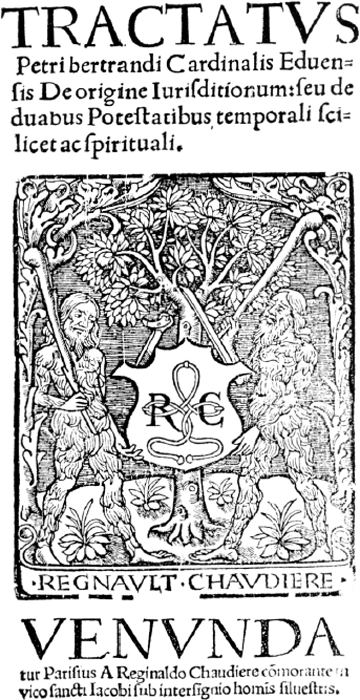 Fig. 19. The ‘Du Pré’ Great Primer [r 110] or Gros-romain (1520) as it appears in lines 2-5 of the title-page of P. Bertrand, Tractatvs de origine iurisdictionum, Paris, J. ii Du Pré for R. Chaudière, c. 1520. Courtesy of the Bibliothèque Mazarine, Paris.
| |||||||||||||||||||||||||||||||||||||||||||||||||||||||||||||||||||||||||||||||||||||||||||||||||||||||||||||||||||||||||||||||||||||||||||||||||||||||||||||||||||||
[pagina 43]
| |||||||||||||||||||||||||||||||||||||||||||||||||||||||||||||||||||||||||||||||||||||||||||||||||||||||||||||||||||||||||||||||||||||||||||||||||||||||||||||||||||||
20. The ‘Desprez’ English-sized Roman [r 91] or Saint-augustin (1520)Among the new founts starting to appear in Paris in the early 1520s, a decently designed Roman on English, approaches the quality of the contemporary one by Colines (17). It most probably originates from the workshop Le Rouge-Desprez, attesting to the advances made in the preceding few years. Size: English (Saint-augustin); 13/12 Anglo-American/Didot points; 20 91 × 2:3 mm. 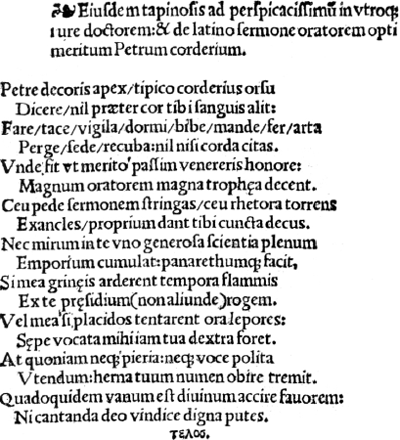 Fig. 20. The ‘Desprez’ English-sized Roman [r 91] or Saint-augustin (1520) as it appears in P. de Ponte, Apologiae ... in literoedones, N. Desprez for B. Aubry, 1520, f. a2. Courtesy of the University Library, Ghent.
| |||||||||||||||||||||||||||||||||||||||||||||||||||||||||||||||||||||||||||||||||||||||||||||||||||||||||||||||||||||||||||||||||||||||||||||||||||||||||||||||||||||
[pagina 44]
| |||||||||||||||||||||||||||||||||||||||||||||||||||||||||||||||||||||||||||||||||||||||||||||||||||||||||||||||||||||||||||||||||||||||||||||||||||||||||||||||||||||
21. The ‘La Barre’ Pica Roman [r 85] or Cicéro (1520)About 1519 or 1520 several new typefaces began to surface in La Barre printings, one of them in Cicero's Oratio pro lege Manilia, dated 1519 by Moreau (2: no. 2015) but which may be from 1520. This work was edited by Jean Vatel, who lived at La Barre's premises, no doubt acting as an editor. He was perhaps involved in the type design, the level-barred lower case e departing from the then usual design. Other sorts, however, remain traditionally designed. The typeface may been cut by the engraver working in Le Rouge's shop. I have seen this face only in La Barre imprints. In 1522 he had another face on the same size, described below in (25). Size: Pica (Cicéro); 12/11.5 Anglo- American/Didot points; 20 85 × 1.8:3 mm. 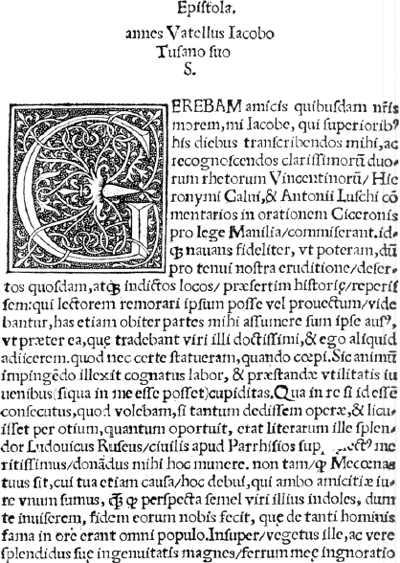 Fig. 21. The ‘La Barre’ Pica [r 85] or Cicéro (1519/1520) as it appears in Cicero, Oratio pro lege Manilia, Paris, N. de La Barre for N. Crespin, 1519, f. a1v. Courtesy of the Bibliothèque Mazarine, Paris.
| |||||||||||||||||||||||||||||||||||||||||||||||||||||||||||||||||||||||||||||||||||||||||||||||||||||||||||||||||||||||||||||||||||||||||||||||||||||||||||||||||||||
[pagina 45]
| |||||||||||||||||||||||||||||||||||||||||||||||||||||||||||||||||||||||||||||||||||||||||||||||||||||||||||||||||||||||||||||||||||||||||||||||||||||||||||||||||||||
22. The ‘La Barre’ Long Primer Roman [r 65] or Petit-romain (1520)At La Barre's press, I have only seen this Long Primer in three printings usually dated 1519, viz. Cicero's Oratio pro lege Manilia, dated 1519 by Moreau (id., 2: no. 2015) but which may be from 1520, Andrelini's Hecatodistichon, datable after 15 July 1519 (id., 2: no. 1973), and Erasmus's Christiani hominis institutum, of c. 1519 (id., 2: no. 2025). The later date of 1520 may be more likely, as La Barre used the Le Rouge Long Primer (12) up to 1519. In 1520 La Barre used the new fount in Pico's Epistole (id., 2: no. 2451). Size: Long Primer Roman (Petit-romain); 9/8.5 Anglo-American/Didot points; 20 65 × 1.5: 2.2 mm. 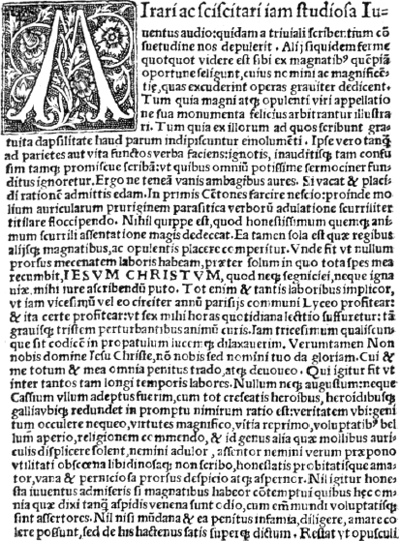 Fig. 22. The ‘La Barre’ Long Primer [r 65] or Petit-romain (1519/1520) as it appears in P. de Ponte, Ars versificatoria, Paris, A. Girault, 1529, f. a1v. Courtesy of the University Library, Ghent.
| |||||||||||||||||||||||||||||||||||||||||||||||||||||||||||||||||||||||||||||||||||||||||||||||||||||||||||||||||||||||||||||||||||||||||||||||||||||||||||||||||||||
[pagina 46]
| |||||||||||||||||||||||||||||||||||||||||||||||||||||||||||||||||||||||||||||||||||||||||||||||||||||||||||||||||||||||||||||||||||||||||||||||||||||||||||||||||||||
The fount reappears in the early 1520s at the Vidoue press (id. 3: no. 354). It is also used from 1524 onwards in several publications of Ambroise Girault, attributed by Moreau (3: nos. 731, 734, 1571, 1890, 1892) to the press of Prigent Calvarin. However, this face is quite different from the Bourgeois [r 62] which Moreau (3: no. 1305) credits to Calvarin. See below (38). The 1519/20 La Barre imprints were edited by Jean Vatel, who was living at La Barre's house and in a foreword to Angeriano's Erotopaignion (Moreau, 3: no. 12) was described as ‘sororius meus’ by an Alanus a Barra. Vatel may have been involved in the design of this type, while the cutting may been been done by the same engraver as mentioned above in the paragraph on Le Rouge's Long Primer (12). It may as well be noted that the La Barre publications display also the Bergmann Great Primer with the variant sorts (5). The relation between the Le Rouge and La Barre Long Primers deserves closer inspection, as well as the occurrence of some odd sorts of these founts in the books of a publisher such as Gromors (Moreau, 3: 1900). | |||||||||||||||||||||||||||||||||||||||||||||||||||||||||||||||||||||||||||||||||||||||||||||||||||||||||||||||||||||||||||||||||||||||||||||||||||||||||||||||||||||
[pagina 47]
| |||||||||||||||||||||||||||||||||||||||||||||||||||||||||||||||||||||||||||||||||||||||||||||||||||||||||||||||||||||||||||||||||||||||||||||||||||||||||||||||||||||
23. Colines's first Bourgeois Roman [r 63] or Gaillarde (1520)This face, reviewed by Vervliet (2003, 125-7), is a faithful copy on a smaller body of Colines's English-bodied Roman, described above in (17). It occurs in two States, the first quire and the last quires (from ggg onwards) of Colines first imprint, the 1520 Montholon, exhibiting the second. This second state is probably the Long Primer Roman, used by the anonymous press of the Crowned Dolphins and described below in (30) but, as this would be a non-proprietary use of a Colines face, I hesitate to be firm in this respect. Size: Bourgeois (Gaillarde); 9/8.5 Anglo-American/Didot points; 20 63 × 1.3: 2 mm. | |||||||||||||||||||||||||||||||||||||||||||||||||||||||||||||||||||||||||||||||||||||||||||||||||||||||||||||||||||||||||||||||||||||||||||||||||||||||||||||||||||||
[pagina 48]
| |||||||||||||||||||||||||||||||||||||||||||||||||||||||||||||||||||||||||||||||||||||||||||||||||||||||||||||||||||||||||||||||||||||||||||||||||||||||||||||||||||||
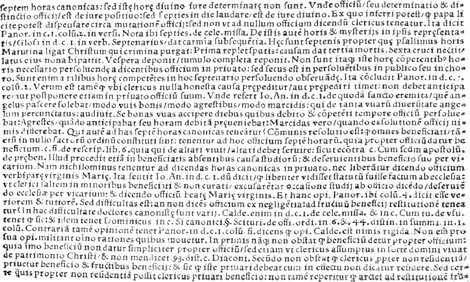 Fig. 23a. First state of Colines's first Bourgeois [r 63] or Gaillarde (1520) as it occurs in J. de Montholon, Promptuarium, Paris, Colines, 1520, vol. 2, f. vii. Courtesy of the Stadsbibliotheek, Antwerp.
| |||||||||||||||||||||||||||||||||||||||||||||||||||||||||||||||||||||||||||||||||||||||||||||||||||||||||||||||||||||||||||||||||||||||||||||||||||||||||||||||||||||
[pagina 49]
| |||||||||||||||||||||||||||||||||||||||||||||||||||||||||||||||||||||||||||||||||||||||||||||||||||||||||||||||||||||||||||||||||||||||||||||||||||||||||||||||||||||
 Fig. 23b. Second state of Colines's first Bourgeois [r 63] or Gaillarde (1520) as it occurs in J. de Montholon, Promptuarium, Paris, Colines, 1520, vol. 1, f. vii. Courtesy of the Stadsbibliotheek, Antwerp. See also Fig. 30.
| |||||||||||||||||||||||||||||||||||||||||||||||||||||||||||||||||||||||||||||||||||||||||||||||||||||||||||||||||||||||||||||||||||||||||||||||||||||||||||||||||||||
[pagina 50]
| |||||||||||||||||||||||||||||||||||||||||||||||||||||||||||||||||||||||||||||||||||||||||||||||||||||||||||||||||||||||||||||||||||||||||||||||||||||||||||||||||||||
24. Colines's first Roman titling on Two-line Bourgeois [R 5.5] or Deux points de Gaillarde (1522)This face is the earliest Colines Roman to exhibit newer and more elegant letterforms (as for instance, in the M, Q, T) and much better than any other Roman titling then appearing in Paris. It has been reviewed by Vervliet (2003, 129). Size: Two-line Bourgeois (Deux points de Gaillarde); 17/16 Anglo- American/Didot points;: 5.5 mm. 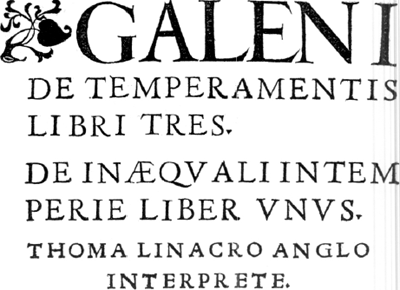 Fig. 24. Colines's first titling on Two-line Long Primer [r 5.5] or Deux points de Petit-romain as it appears on the title-page of Galenus, De temperamentis, Paris, Colines, 1523. The woodcut headline is probably also by Colines. Courtesy of the Stadsbibliotheek, Antwerp.
| |||||||||||||||||||||||||||||||||||||||||||||||||||||||||||||||||||||||||||||||||||||||||||||||||||||||||||||||||||||||||||||||||||||||||||||||||||||||||||||||||||||
[pagina 51]
| |||||||||||||||||||||||||||||||||||||||||||||||||||||||||||||||||||||||||||||||||||||||||||||||||||||||||||||||||||||||||||||||||||||||||||||||||||||||||||||||||||||
25. Vatel's Pica Roman [r 86] or Cicéro (1522)This new fount has been noticed in two Vatel imprints, both for La Barre, viz. the Vaccaeus of 1522 and the Angeriano, dated c. 1521 by Moreau (3: 51, no. 12) but which may be somewhat later as Vatel's death is mentioned in its preface. The fount occurs also in P. De Ponte, Duplicis computi... delectanea, published by La Barre and (mis)dated c. 1510 by stc France (1: 362) and Bibliotheca Belgica (4: 709, no. p 301). The engraver of this fount may have been Vatel. He is credited with two Greeks (Vervliet, 2002, 13-15) and was possibly La Barre's son-in-law; see above (22). Size: Pica (Cicéro); 12/11.5 Anglo-American/Didot points; 20 86 × 1.8:2.8 mm. 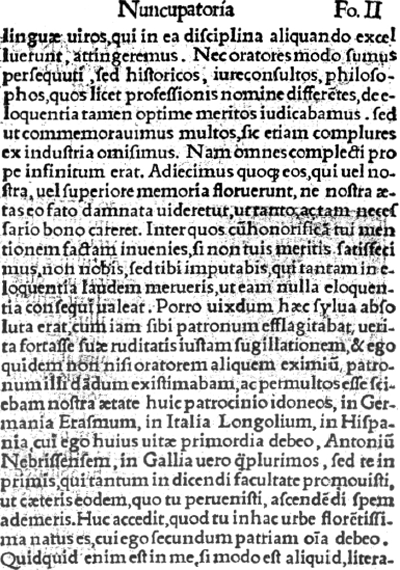 Fig. 25. Vatel's Pica [r 86] or Cicéro (1522) as it appears in J. Vacet, Sylva, Paris, N. de La Barre, 1522, f. a2. Courtesy of the Bibliothèque Mazarine, Paris.
| |||||||||||||||||||||||||||||||||||||||||||||||||||||||||||||||||||||||||||||||||||||||||||||||||||||||||||||||||||||||||||||||||||||||||||||||||||||||||||||||||||||
[pagina 52]
| |||||||||||||||||||||||||||||||||||||||||||||||||||||||||||||||||||||||||||||||||||||||||||||||||||||||||||||||||||||||||||||||||||||||||||||||||||||||||||||||||||||
26. Colines's first Small Pica Roman [R 75] or Philosophie (1522)This is a rarely used Small Pica, Colines apparently preferring to use the 1499 Tholoze Pica (8) and from 1524 onwards his famous second Small Pica Roman of (35) below. It has been reviewed by Vervliet (2003, 128). Size: Small Pica (Philosophie); 10.5/10 Anglo-American/Didot points; 20 75 × 1.5: 2.5 mm.  Fig. 26. Colines's first Small Pica [r 75] or Philosophie (1522) as it appears in J. Lefevre d'Etaples, Epitome... in libros arithmeticos... Boetij, Paris, Colines, 1522, p. 48. Courtesy of the University Library, Copenhagen.
| |||||||||||||||||||||||||||||||||||||||||||||||||||||||||||||||||||||||||||||||||||||||||||||||||||||||||||||||||||||||||||||||||||||||||||||||||||||||||||||||||||||
[pagina 53]
| |||||||||||||||||||||||||||||||||||||||||||||||||||||||||||||||||||||||||||||||||||||||||||||||||||||||||||||||||||||||||||||||||||||||||||||||||||||||||||||||||||||
27. The ‘Vidoue’ Brevier Roman [r 51] or Petit-texte (1522)Vidoue and Colines were the first in Paris to launch a series of pocket books in a 24o or 16o format (Shaw, 1974). Colines used a Bourgeois size [r 63] while Vidoue employed this smaller-sized Brevier [r 51]. In style the face recalls the La Barre Long Primer Roman (22) and may originate from the same local source. Size: Brevier (Petit-texte); 7.2/6.8 Anglo-American/Didot points; 20 51 × 1: 1.5 mm.  Fig. 27. The ‘Vidou’ Brevier [r 51] or Petit-texte (1522) as it appears in Erasmus, Paraphrases... in omnes epistolas Pauli, Paris, P. Vidoue, 1523, f. a1v-a2. Courtesy of the Royal Library, The Hague.
| |||||||||||||||||||||||||||||||||||||||||||||||||||||||||||||||||||||||||||||||||||||||||||||||||||||||||||||||||||||||||||||||||||||||||||||||||||||||||||||||||||||
[pagina 54]
| |||||||||||||||||||||||||||||||||||||||||||||||||||||||||||||||||||||||||||||||||||||||||||||||||||||||||||||||||||||||||||||||||||||||||||||||||||||||||||||||||||||
28. The ‘Vidoue’ Nonpareil Roman [r 43] (1522)A Nonpareil type size was a rarity in early sixteenth-century typography and only owned by the better equipped printers. In Italy, smallsized Italics (though still in the Minion range, 49/45 mm), were employed by Paganini in 1515 and Griffo in 1516 (Isaac, 1938, pls. 15 and 22). In France, small-sized Romans below the Bourgeois/Long Primer range (60-67 mm/20 lines) became popular in the early 1520s, in first instance for Bibles in pocket format (Shaw, 1974). In Paris, Vidoue introduced a true Nonpareil Roman in 1521 or perhaps more probably in 1522, if we may assume that the dating was more Gallico. As far as I know, he used this tiny face only in 1522, e.g. for a Gospel, a Proverbia Salomonis, and a Vergilius, all printed for Pierre Viart (Moreau, 3: nos. 26-27, 410). Subsequently he seems to have preferred to set his pocket books in his Brevier Roman, described in (27). Was the Nonpareil fount owned by Viart or was the change to a bigger face simply a matter of readability? Later, from 1533 onwards, both Colines and Estienne had their own versions of Nonpareil Romans (Vervliet, 2003, 144; 2004, 130). In 1553, Haultin introduced his Nonpareil, both in Italic and Roman, which captured the market far into in the seventeenth century (Vervliet, 2000, 96-98). Size: Nonpareil; 6/5.5 Anglo-American/Didot points; 20 43 × 1; 1.4 mm. 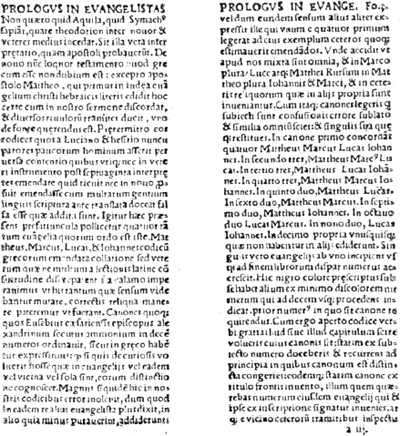 Fig. 28. The ‘Vidoue’ Nonpareil [r 43] (1522) as it appears in Opus quattuor Evangelistarum, Paris, P. Vidoue for P. Viart, 1521/22, f. a2v-a3. Courtesy of the University Library, Louvain-la-Neuve.
| |||||||||||||||||||||||||||||||||||||||||||||||||||||||||||||||||||||||||||||||||||||||||||||||||||||||||||||||||||||||||||||||||||||||||||||||||||||||||||||||||||||
[pagina 55]
| |||||||||||||||||||||||||||||||||||||||||||||||||||||||||||||||||||||||||||||||||||||||||||||||||||||||||||||||||||||||||||||||||||||||||||||||||||||||||||||||||||||
29. Colines's Roman titling on Two-line Brevier [r 4] or Deux points de Petit-texte (1523)Two new titlings, this one on: 4 mm, the other on: 5.2 mm (32), appear from 1523/24 onwards in Colines's books. Both break away from the Basle tradition of type design and introduce in France elements of Aldine letterforms. This fount has been reviewed by Vervliet (2003, 132). Size: Two-line Brevier (Deux points de Petit-texte); 15/14 Anglo-American/Didot;: 4 mm. 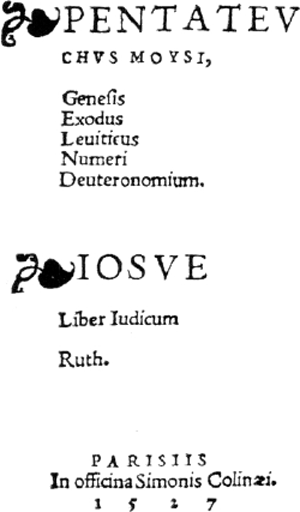 Fig. 29. Colines's titling on Two-line Brevier [r 4] or Deux points de Petit-texte (1523) as it appears on the title-page of Pentatevchvs Moysi, Paris, Colines, 1527. Courtesy of the Aargauische Kantonsbibliothek, Aarau.
| |||||||||||||||||||||||||||||||||||||||||||||||||||||||||||||||||||||||||||||||||||||||||||||||||||||||||||||||||||||||||||||||||||||||||||||||||||||||||||||||||||||
[pagina 56]
| |||||||||||||||||||||||||||||||||||||||||||||||||||||||||||||||||||||||||||||||||||||||||||||||||||||||||||||||||||||||||||||||||||||||||||||||||||||||||||||||||||||
30. The ‘Dauphins’ Long Primer Roman [r 65] or Petit-romain (1523)Moreau (3: 155) suggests that in the years 1521 to 1528 a hitherto unknown press has been operating in Paris. Eponymously named after its usual title-page border with two crowned dolphins, it produced mainly short and shoddily printed texts for classroom use. Apart from this Long Primer, the press used the usual Paris Romans, described above (5, 8, 16). The face reappears from 1531 onwards in imprints ascribed by Moreau to Jean Bignon. On the possible relation with a fount used by S. de Colines and P. Viart, see above (23). Size: Long Primer (Petit-romain); 9/8.5 Anglo-American/Didot points; 20 65 × 1.4: 2.1 mm. 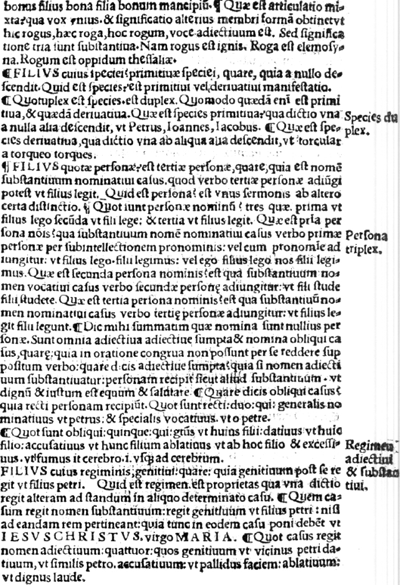 Fig. 30. The ‘Dauphins’ Long Primer [r 65] or Petit-romain (1523) as it appears in P. de Ponte, Duplex Grammaticae artis Isagoge, Paris, R.Chaudière, 1524, f. a5. See also
Fig. 23b. Courtesy of the University Library, Ghent. | |||||||||||||||||||||||||||||||||||||||||||||||||||||||||||||||||||||||||||||||||||||||||||||||||||||||||||||||||||||||||||||||||||||||||||||||||||||||||||||||||||||
[pagina 57]
| |||||||||||||||||||||||||||||||||||||||||||||||||||||||||||||||||||||||||||||||||||||||||||||||||||||||||||||||||||||||||||||||||||||||||||||||||||||||||||||||||||||
31. Coline's second Bourgeois Roman [r 63] or Gaillarde (1523)For a series of small-sized Bible parts in sextodecimo, published from 1523 onwards under the editorship of his stepson Robert i Estienne (Armstrong, 1986, 325), Colines apparently engraved three new typefaces, this Bourgeois and two titlings of 4 mm and 5.5 mm respectively (24, 29). The three new founts are designed boldly and forcefully. They are the first Romans cut in France whose designs surpass the current Basle typefaces and can compete with the renowned Aldine models (Barker, 1974, 8). This type has been reviewed by Vervliet (2003, 130). Size: Bourgeois (Gaillarde); 9/8.5 Anglo-American/Didot points; 20 63 × 1.3: 2 mm.  Fig. 31a. Colines's second Bourgeois [r 63] or Gaillarde (1523) assembled from Textor, Stirpivm differentiae, Paris, Colines, 1534. Courtesy of the Stadsbibliotheek, Antwerp.
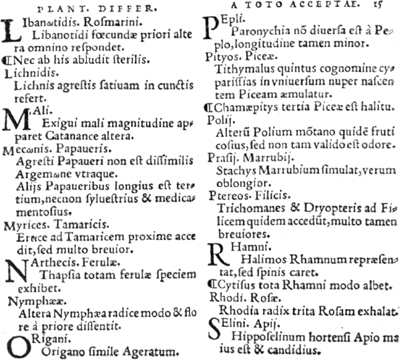 Fig. 31b. Coline's second Bourgeois [r 63] or Gaillarde (1523) as it appears in Textor, Stirpivm differentiae, Paris, Colines, 1534, f. 15. Courtesy of the Stadsbibliotheek, Antwerp.
| |||||||||||||||||||||||||||||||||||||||||||||||||||||||||||||||||||||||||||||||||||||||||||||||||||||||||||||||||||||||||||||||||||||||||||||||||||||||||||||||||||||
[pagina 58]
| |||||||||||||||||||||||||||||||||||||||||||||||||||||||||||||||||||||||||||||||||||||||||||||||||||||||||||||||||||||||||||||||||||||||||||||||||||||||||||||||||||||
32. Colines's second Roman titling on Two-line Bourgeois [r 5.5] or Deux points de Gaillarde (1522)A few years after he introduced his first titling of this size (24), Colines began to use two newly cut Roman titlings, this one and the other described in (29). Their design can be considered as the first proper typographic rendering, North of the Alps, of the classical capitalis monumentalis, well before this was popularized there by the treatises of Dürer (1525) and Tory (1529). Size: Two-line Bourgeois (Deux points de Gaillarde); 17/16 Anglo-American/Didot points;: 5.2 mm.  Fig. 32a. Colines's second titling on Two-line Long Primer [r 5.2] or Deux points de Petit-romain (1524) as it occurs in line 2 of the title-page of J. Clichthove, Propvgnacvlvm ecclesiae, Paris, Colines, 1526. Courtesy of the Stadsbibliotheek, Antwerp.
 Fig. 32b. Colines's second titling on Two-line Long Primer [r 5.2] or Deux points de Petit-romain (1524) assembled from Textor, Stirpivm differentiae, Paris, Colines, 1534. Courtesy of the Stadsbibliotheek, Antwerp.
| |||||||||||||||||||||||||||||||||||||||||||||||||||||||||||||||||||||||||||||||||||||||||||||||||||||||||||||||||||||||||||||||||||||||||||||||||||||||||||||||||||||
[pagina 59]
| |||||||||||||||||||||||||||||||||||||||||||||||||||||||||||||||||||||||||||||||||||||||||||||||||||||||||||||||||||||||||||||||||||||||||||||||||||||||||||||||||||||
33. The ‘Vidoue’ first Roman titling on Two-line Long Primer [r 6.2] or Deux points de Petit-romain (1525)This titling clearly is an answer to the Colines forints on the same size of 1522 and 1524 (24, 29) and the bigger sized Basle titlings of 1517 [r 8.5] and 1521 [r 14.5]. A link with Martin Caesar in Antwerp is possible, as he owned a bold version of this fount. Size: Two-line Long Primer (Deux points de Petit-romain); 19/18 Anglo-American/Didot points;: 6.2 mm.  Fig. 33. The ‘Vidoue’ first titling on Two-line Small Pica [r 6.2] or Deux points de Philosophie (1525) as it appears in in Erasmus, Opvs de conscribendis epistolis, Paris, [P. Gromors &] G. Le Bret, 1527, f. a2v. Courtesy of the University Library, Ghent.
| |||||||||||||||||||||||||||||||||||||||||||||||||||||||||||||||||||||||||||||||||||||||||||||||||||||||||||||||||||||||||||||||||||||||||||||||||||||||||||||||||||||
[pagina 60]
| |||||||||||||||||||||||||||||||||||||||||||||||||||||||||||||||||||||||||||||||||||||||||||||||||||||||||||||||||||||||||||||||||||||||||||||||||||||||||||||||||||||
34. The ‘Vidoue’ Roman on Large English [r 100] or Gros-texte (1525)A rough English-sized Roman, ostensibly by a less-qualified cutter, occurs in the mid of the 1520s in a few imprints of Vidoue and Gromors. It is unclear why Vidoue introduced it, as he owned and regularly used a fount of the much better Bergmann (5) and Cervicornus Romans (14). Size: Large English (Gros-texte); 14/13 Anglo-American/Didot points; 20 100 × 2: 3.4 mm. 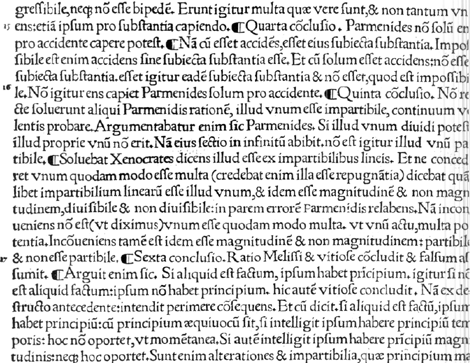 Fig. 34. The ‘Vidoue’ Roman on Large English [r 100] or Gros-texte (1525) as it appears in J. Lefèvre d'Etaples, In quoscunque Philosophiae... Paraphrasis, Paris, P. Vidoue & F. Regnault, 1525, f. b3, intermixed with sorts of the Bergmann Great Primer. Courtesy of the University Library, Ghent.
| |||||||||||||||||||||||||||||||||||||||||||||||||||||||||||||||||||||||||||||||||||||||||||||||||||||||||||||||||||||||||||||||||||||||||||||||||||||||||||||||||||||
[pagina 61]
| |||||||||||||||||||||||||||||||||||||||||||||||||||||||||||||||||||||||||||||||||||||||||||||||||||||||||||||||||||||||||||||||||||||||||||||||||||||||||||||||||||||
35. Colines's second Small Pica Roman [r 73] or Philosophie (1525)From 1525 onwards this Small Pica became Colines's workhorse for compositions in the octavo format. He used it over his whole career. The fount has been reviewed by Vervliet (2003, 134-5). Size: Small Pica (Philosophie); 10.5/10 Anglo-American/Didot points; 20 73 × 1.5: 2.4 mm. 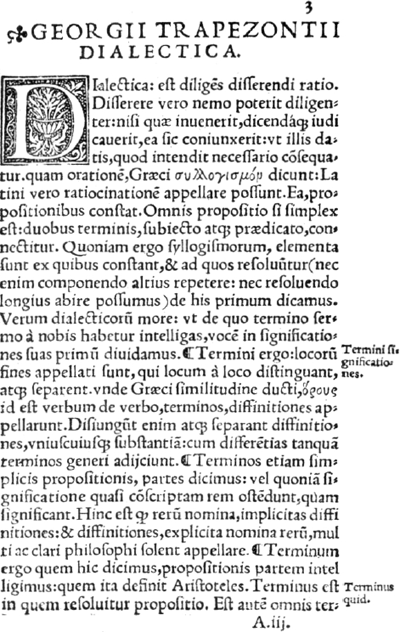 Fig. 35a. Colines's Small Pica [r 73] or Philosophie (1525) as it appears in Georgius Trapezuntius, Dialectica, Paris, Colines, 1528, f. a2v-a3. Courtesy of the Stadsbibliotheek, Antwerp.
 Fig. 35b. Colines's Small Pica [r 73] or Philosophie (1525) assembled from P. Anghiera [Pierre Martyr], Extraict ov recveil des isles, Paris, Colines, 1532. Courtesy of the Stadsbibliotheek, Antwerp.
| |||||||||||||||||||||||||||||||||||||||||||||||||||||||||||||||||||||||||||||||||||||||||||||||||||||||||||||||||||||||||||||||||||||||||||||||||||||||||||||||||||||
[pagina 62]
| |||||||||||||||||||||||||||||||||||||||||||||||||||||||||||||||||||||||||||||||||||||||||||||||||||||||||||||||||||||||||||||||||||||||||||||||||||||||||||||||||||||
36. The ‘Chevailon’ Roman Titling on Two-line Bourgeois [R 5.2] or Deux points de Gaillarde (1526)A Roman titling by an unskilled engraver appears at Chevallon's press from 1526 to 1543, perhaps as a (poor) answer to Colines 1524 titling (32). Another titling appearing in Erasmus's De duplici copia of 1526 (Versailles, Bibliothèque de la Ville, fa 8o e 1190; Moreau, 3: 291, no. 990) with a Girault imprint and attributed by Moreau to Calvarin in 1526 is probably a woodcut. Size: Two-line Bourgeois (Deux points de Gaillarde); 17/16 Anglo-American/Didot points;: 5.2 mm.  Fig. 36. The ‘Chevallon’ Roman Titling on Two-line Long Primer [r 5.2] or Capitales de deux points de Petit-romain (1526) assembled from G. Pachymerus, Paraphrasis in decem epistolas B. Dionysii Areopagitae, Paris, Ch. Guillard, 1538. Courtesy of the Stadsbibliotheek, Antwerp.
| |||||||||||||||||||||||||||||||||||||||||||||||||||||||||||||||||||||||||||||||||||||||||||||||||||||||||||||||||||||||||||||||||||||||||||||||||||||||||||||||||||||
[pagina 63]
| |||||||||||||||||||||||||||||||||||||||||||||||||||||||||||||||||||||||||||||||||||||||||||||||||||||||||||||||||||||||||||||||||||||||||||||||||||||||||||||||||||||
37. Colines's second English-bodied Roman [R 90] or Saint-augustin (1526)Colines used this Saint-augustin sparsely, mainly between 1526 and 1531. It is wholly in Colines's forceful style he uses from the mid 1520s onwards. It became outdated after the aesthetic revolution introduced by the Estienne Romans (1530). The Colines fount has been reviewed by Vervliet (2003, 137-8). Key letters: Splayed singly-seriffed capital M; two forms of Q; tilted-bowl lower case e; ligature fi with stroked i, large upper and lower counters of g; thin diagonal of z. Lozenge-shaped colon, question mark and period. Accented sorts. 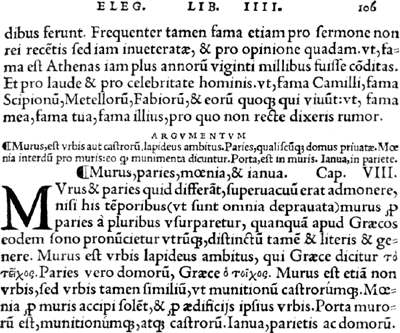 Fig. 37. Colines's second English-bodied Roman [r 90] or Saint-augustin (1526) as it appears in L. Valla, Epitome, Paris, S. de Colines, 1529, p. 106. Courtesy of the University Library, Ghent.
| |||||||||||||||||||||||||||||||||||||||||||||||||||||||||||||||||||||||||||||||||||||||||||||||||||||||||||||||||||||||||||||||||||||||||||||||||||||||||||||||||||||
[pagina 64]
| |||||||||||||||||||||||||||||||||||||||||||||||||||||||||||||||||||||||||||||||||||||||||||||||||||||||||||||||||||||||||||||||||||||||||||||||||||||||||||||||||||||
38. The ‘Calvarin’ Bourgeois Roman [R 62] or Gaillarde (1526)A crude Roman attributed by Moreau (3: no. 865) to Gromors, appears in a Boulle imprint dated c. 1525 and the following year at the Chevallon press, which used it until the early 1530s. But it seems rather attributable to Prigent Calvarin, at least if the attribution of the 1527 Poliziano (Moreau, 3: no. 1305) to him is to be followed. It is unclear whether the Savetier Long Primer (40), which is very similar and can be linked to Martinus Caesar in Antwerp, must be seen as a different face or as a variant. On the relation to the La Barre Long Primer, see above (22). Size: Bourgeois (Gaillarde); 9/8 Anglo-American/Didot points; 20 62 × 1.5: 2 mm. 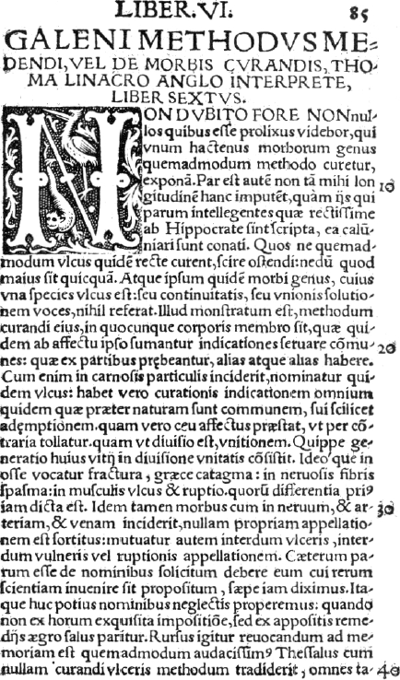 Fig. 38. The ‘Calvarin’ Bourgeois [r 62] or Gaillarde (1526) as it appears in Galenus, Methodus medendi, Paris, C. Chevallon, 1526, p. 85. Courtesy of the University Library, Ghent.
| |||||||||||||||||||||||||||||||||||||||||||||||||||||||||||||||||||||||||||||||||||||||||||||||||||||||||||||||||||||||||||||||||||||||||||||||||||||||||||||||||||||
[pagina 65]
| |||||||||||||||||||||||||||||||||||||||||||||||||||||||||||||||||||||||||||||||||||||||||||||||||||||||||||||||||||||||||||||||||||||||||||||||||||||||||||||||||||||
39. Colines's Minion Roman [r 49] or Mignonne (1526)Mostly used for marginalia and in the same bold style as the other Colines Romans of the period, this Minion has not been seen outside the Colines and Blaubloom presses, except for a few appearances in some other Paris imprints, which probably can be attributed to Blaubloom's press (Moreau, 4: nos. 316, 586 and 1111). This Minion has been reviewed by Vervliet (2003, 136). Size: Minion (Mignonne); 7/6.5 Anglo-American/Didot points; 20 49 × 1:1.6 mm. 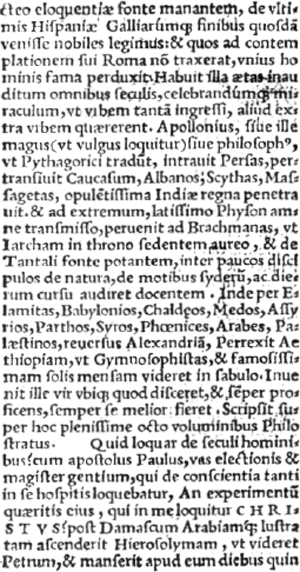 Fig. 39. Colines's Minion [r 49] or Mignonne (1527) as it appears in the Pentatevchvs Moysi, Paris, Colines, 1527, f. a2v. Courtesy of the Aargauische Kantonsbibliothek, Aarau.
| |||||||||||||||||||||||||||||||||||||||||||||||||||||||||||||||||||||||||||||||||||||||||||||||||||||||||||||||||||||||||||||||||||||||||||||||||||||||||||||||||||||
[pagina 66]
| |||||||||||||||||||||||||||||||||||||||||||||||||||||||||||||||||||||||||||||||||||||||||||||||||||||||||||||||||||||||||||||||||||||||||||||||||||||||||||||||||||||
40. The ‘Savetier’ Long Primer Roman [r 65] or Petit-romain (1527)A rough local face, very similar to Calvarin's Bourgeois described in (38). It deserves more research to clear up in as far both founts originate from the same source and Martinus Caesar, who in those years emigrated from Paris to Antwerp, is involved. Size: Long Primer (Petit-romain); 9/8.5 Anglo-American/Didot points; 20 65 × 1.4: 2.1 mm. 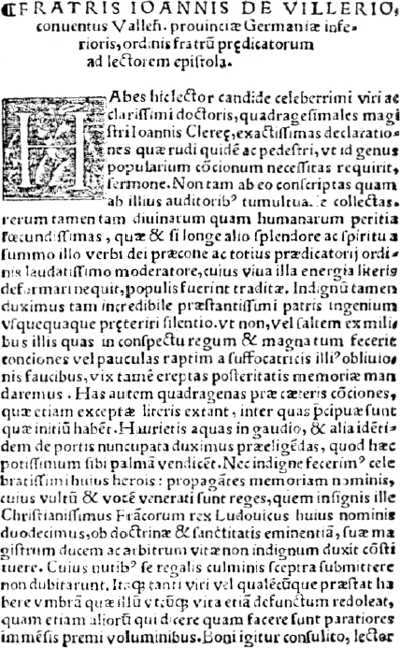 Fig. 40. The ‘Savetier’ Long Primer [r 65] or Petit-romain (1529) as it appears in J. Clereas, Sermones quadragesimales, Paris, N. Savetier, 1530, f. a1v, Courtesy of the Royal Library, The Hague.
| |||||||||||||||||||||||||||||||||||||||||||||||||||||||||||||||||||||||||||||||||||||||||||||||||||||||||||||||||||||||||||||||||||||||||||||||||||||||||||||||||||||
[pagina 67]
| |||||||||||||||||||||||||||||||||||||||||||||||||||||||||||||||||||||||||||||||||||||||||||||||||||||||||||||||||||||||||||||||||||||||||||||||||||||||||||||||||||||
41. Colines's first Great Primer Roman [r 117] or Gros-romain (1528)Mid 1528 Colines ceased using the 1494 Bergmann Great-Primer Roman (5) as the usual text type for his quartos and folios. Its capitals reveal the new sensibility of a talented type designer for imitating more closely the letterforms of the classical inscriptional capital. This Great Primer, which has been described by Vervliet (2003, 142-3), has not been seen outside the Colines and Blaubloom presses, except for an appearance in a Wechel imprint, which probably can be attributed to Blaubloom's press (Moreau, 4: no. 316). Size: Great Primer (Gros-romain); 16.5/15.5 Anglo-American/Didot points; 20 117 × 2:3.7 mm. 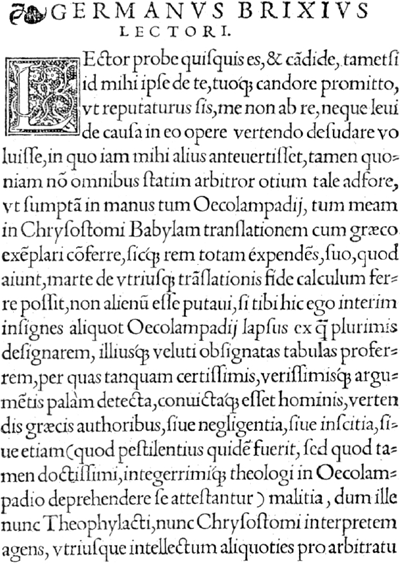 Fig. 41. Colines's first Great Primer [r 117] or Gros-romain (1528) as it appears in Joannes Chrysostomus, Liber contre gentiles, Paris, Colines, 1528, f. a1. Courtesy of the University Library, Ghent.
| |||||||||||||||||||||||||||||||||||||||||||||||||||||||||||||||||||||||||||||||||||||||||||||||||||||||||||||||||||||||||||||||||||||||||||||||||||||||||||||||||||||
[pagina 68]
| |||||||||||||||||||||||||||||||||||||||||||||||||||||||||||||||||||||||||||||||||||||||||||||||||||||||||||||||||||||||||||||||||||||||||||||||||||||||||||||||||||||
42. The ‘Leber’ Smal Pica Roman [r 70] or Philosophie (1528)A rather uneven face only seen at Leber's press. Size: Small Pica (Philosophie); 10/9.5 Anglo-American/Didot points; 20 70 × 1.5:2.2 mm. 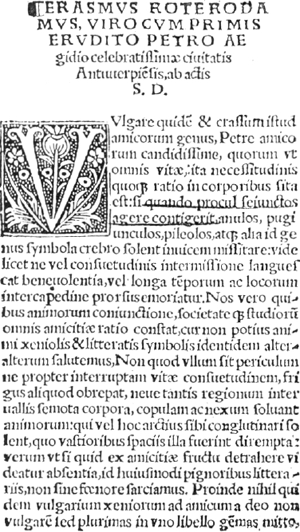 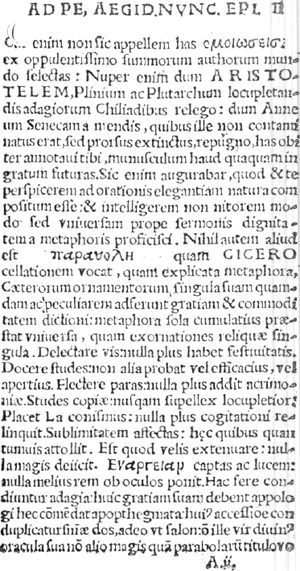 Fig. 42. The ‘Leber’ Small Pica [r 70] or Philosophie (1528) as it appears in Erasmus, Parabolae, Paris, P. Leber, 1528, f. a1-a1v. Courtesy of the Royal Library, Brussels.
| |||||||||||||||||||||||||||||||||||||||||||||||||||||||||||||||||||||||||||||||||||||||||||||||||||||||||||||||||||||||||||||||||||||||||||||||||||||||||||||||||||||
[pagina 69]
| |||||||||||||||||||||||||||||||||||||||||||||||||||||||||||||||||||||||||||||||||||||||||||||||||||||||||||||||||||||||||||||||||||||||||||||||||||||||||||||||||||||
43. The ‘Vidoue’ Bourgeois Roman [r 64] or Gaillarde (1528)A small-sized and rather second-rate Roman appears at Vidoue's press at the end of the 1530s, ostensibly as an attempt to modernize somewhat its type cases. Moreover, it occurs in the Versailles copy sine dato (anc. fa in-12 e 411f) of Erasmus's Colloquia in 24o, sometimes improperly dated 1527 and attributed to Colines (Moreau, 3: no. 1200). It is also the Roman which Moreau (5: 104, no. 187) attributes to Savetier though it differs from Savetier's fount described above (40). Size: Bourgeois (Gaillarde); 9/8.5 Anglo-American/Didot points; 20 64 × 1.5:2 mm. 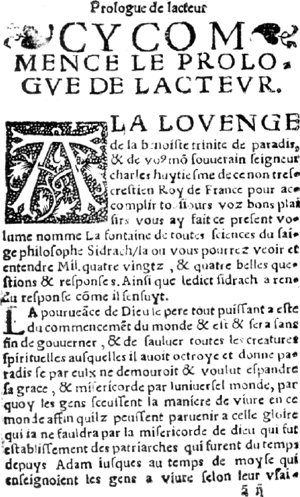 Fig. 43. The ‘Vidou’ Bourgeois [r 64] or Gaillarde (1528) as it appears in Sidrac. Mil iiii vingtz et quatre demandes, Paris, G. Du Pré & P. Vidoue, 1531, f. a2. Courtesy of the University Library, Ghent.
| |||||||||||||||||||||||||||||||||||||||||||||||||||||||||||||||||||||||||||||||||||||||||||||||||||||||||||||||||||||||||||||||||||||||||||||||||||||||||||||||||||||
[pagina 70]
| |||||||||||||||||||||||||||||||||||||||||||||||||||||||||||||||||||||||||||||||||||||||||||||||||||||||||||||||||||||||||||||||||||||||||||||||||||||||||||||||||||||
44. The ‘Vidoue’ Roman titling on Two-line Great Primer [r 10.5] or Deux points de Gros-romain (1529)Vidoue had three new sets of Roman titlings engraved about 1529 (44, 46, 51). All three exhibit common characteristics. Basically they follow the design of the 1517 r 8.5 Basle capitals (which appeared in Paris from 1530 onwards) but amplify the serifs to oversized spiky spurs, somewhat similar to the fourth-century litterae Damasianae. The direct source of this mannerism is unclear. It may be a reminiscence of the forked terminals (a feature of the then current initials with uncial letterforms) or perhaps more likely (as William Kemp privately suggested) they may imitate the letterforms of some decorated initials with the playing children appearing at Vidoue's and Wechel's presses from 1527 and 1529 onwards respectively. Koegler (1936, 1935, fig. 43) suggests that these were engraved by the Basle Master C.V. after Holbein. Similar mannerisms appear in two sets of decorated initials, used by Augereau in the early 1530s (Veyrin-Forrer, 1987, 34-5). Size: Two-line Great Primer (Deux points de Gros-romain); 30/28 Anglo-American/Didot points;: 10.5 mm. 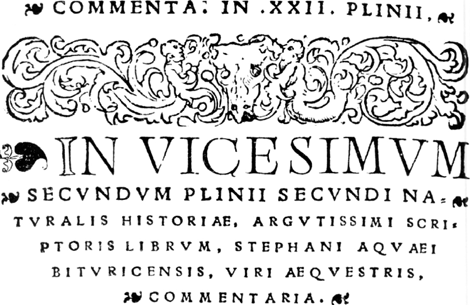 Fig. 44. The ‘Vidoue’ titling on Two-line Great Primer [r 10.5] or Deux points de Gros-romain (1529) as it appears in E. de Laigue, In omnes C. Plinii... commentaria, Paris, P. Vidoue, 1530, f. aa6v. Courtesy of the Stadsbibliotheek, Antwerp.
| |||||||||||||||||||||||||||||||||||||||||||||||||||||||||||||||||||||||||||||||||||||||||||||||||||||||||||||||||||||||||||||||||||||||||||||||||||||||||||||||||||||
[pagina 71]
| |||||||||||||||||||||||||||||||||||||||||||||||||||||||||||||||||||||||||||||||||||||||||||||||||||||||||||||||||||||||||||||||||||||||||||||||||||||||||||||||||||||
45. Colines's Roman titling on Two-line English [r 8.5] or Deux points de Saint-augustin (1529)In Colines's printings this titling supersedes from 1529 onwards the first and rather weak 9.5 mm titling Colines engraved for Henri i Estienne in 1518 (15), as well as the woodcut headline lettering appearing from 1523 onwards or the 5.2 mm Roman titling of (24) above. Its letterforms are strong, sturdy, bold. These features seem to summarize Colines's thought about the ideal Roman letterform. It is, in my opinion, a wholly satisfying typeface, one of the best to appear in the sixteenth century. At the time of its appearance in 1529, it had in Paris, qualitatively and aesthetically, no competitor. The Colines titling is contemporaneous with the 7.5 and 5.5 mm Roman titlings appearing at Tory's press (47, 49). The Colines titling has been reviewed by Vervliet (2003, 140-1). Size: Two-line English (Deux points de Saint-augustin); 27/24 Anglo-American/Didot points;: 8/8.5 mm.  Fig. 45a. Colines's titling on Two-line English [r 8.5] or Deux points de Saint-augustin (1529) as it occurs on the title-page of Terentianus, De literis, Paris, Colines, 1531. Courtesy of the Stadsbibliotheek, Antwerp.
| |||||||||||||||||||||||||||||||||||||||||||||||||||||||||||||||||||||||||||||||||||||||||||||||||||||||||||||||||||||||||||||||||||||||||||||||||||||||||||||||||||||
[pagina 72]
| |||||||||||||||||||||||||||||||||||||||||||||||||||||||||||||||||||||||||||||||||||||||||||||||||||||||||||||||||||||||||||||||||||||||||||||||||||||||||||||||||||||
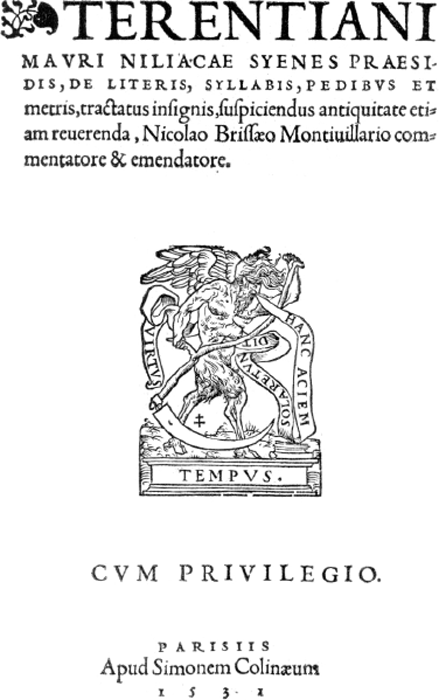 Fig. 45b. Colines's titling on Two-line English [r 8.5] or Deux points de Saint-augustin (1529) assembled from P. Anghiera [Pierre Martyr], Extraict ov recveil des isles, Paris, Colines, 1532 (Courtesy of the Stadsbibliotheek, Antwerp) and Galenus, De cavsis respirationis, Paris, Colines, 1533. Courtesy of the Royal Library, The Hague.
| |||||||||||||||||||||||||||||||||||||||||||||||||||||||||||||||||||||||||||||||||||||||||||||||||||||||||||||||||||||||||||||||||||||||||||||||||||||||||||||||||||||
[pagina 73]
| |||||||||||||||||||||||||||||||||||||||||||||||||||||||||||||||||||||||||||||||||||||||||||||||||||||||||||||||||||||||||||||||||||||||||||||||||||||||||||||||||||||
46. The ‘Gromors’ Roman titling on Two-line English [r 8.5] or Deux points de Saint-augustin (1529)A bold Roman titling in the same style as the two Tory titlings (47, 49) occurs sporadically at an anonymous Paris press, possibly Gromors's as suggested by Moreau (3: nos. 1748 and 1900; 4: no. 1348). I did not see this face appearing in named Tory imprints. Size: Two-line Pica (Deux points de Cicéro); 23.5/22 Anglo-American/Didot points;: 8,5 mm.  Fig. 46. The ‘Gromors’ titling on Two-line English [r 8.5] or Deux points de Saint-augustin (1529) as it appears in Erasmus, Brevissima... epistolarum formula, Paris, [P. Gromors], 1529. Courtesy of the University Library, Ghent.
| |||||||||||||||||||||||||||||||||||||||||||||||||||||||||||||||||||||||||||||||||||||||||||||||||||||||||||||||||||||||||||||||||||||||||||||||||||||||||||||||||||||
[pagina 74]
| |||||||||||||||||||||||||||||||||||||||||||||||||||||||||||||||||||||||||||||||||||||||||||||||||||||||||||||||||||||||||||||||||||||||||||||||||||||||||||||||||||||
47. The ‘Tory’ Roman titling on Two-line Small Pica [r 7.5] or Deux points de Philosophie (1529)Three series of inscriptional capitals, all in the same style, appeared from the end of the 1520s onwards. The largest one [r 8.5], eponymously named after Gromors, is described in (46). Two others can be linked to Tory. The medium one [r 7.5] is described here and the smaller r 5.5 in (49). The three faces ignore the proportions and letterforms as prescribed by Tory in his Champfleury. They rather seem to copy hesitatingly the bold Roman titling Simon de Colines introduced in 1528 (45). Size: Two-line Small Pica (Deux points de Philosophie); 24/23 Anglo-American/Didot points;: 7.5 mm. 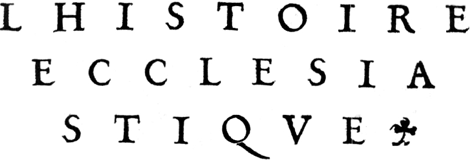 Fig. 47. The ‘Tory’ titling on Two-line Pica [r 7.5] or Deux points de Philosophie (1529) as it appears on the title-page of Eusebius Caesariensis, Lhistoire ecclesiastique, Paris, G. Tory, 1532. Courtesy of the Bibliothèque municipale, Troyes.
| |||||||||||||||||||||||||||||||||||||||||||||||||||||||||||||||||||||||||||||||||||||||||||||||||||||||||||||||||||||||||||||||||||||||||||||||||||||||||||||||||||||
[pagina 75]
| |||||||||||||||||||||||||||||||||||||||||||||||||||||||||||||||||||||||||||||||||||||||||||||||||||||||||||||||||||||||||||||||||||||||||||||||||||||||||||||||||||||
48. The second ‘Vidoue’ Roman titling on Two-line Long Primer [r 6.2] or Deux points de Petit-romain (1529)A second Vidoue titling appearing in the same year 1529; in the same decorated style as (44) and (51). Size: Two-line Long Primer (Deux points de Petit-romain); 20/19 Anglo-American/Didot points;: 6.2 mm. 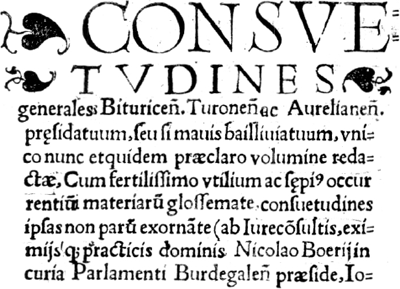 Fig. 48. The ‘Vidoue’ second titling on Two-line Small Pica [r 6.2] or Deux points de Cicéro (1529) as it appears in line 2 of the title-page of the Consuetudines generales Bituricensium, Turonensium et Aurelianensium, Paris, G. i Du Pré, F. Regnault, P. Vidoue, 1529. Courtesy of the University Library, Ghent.
| |||||||||||||||||||||||||||||||||||||||||||||||||||||||||||||||||||||||||||||||||||||||||||||||||||||||||||||||||||||||||||||||||||||||||||||||||||||||||||||||||||||
[pagina 76]
| |||||||||||||||||||||||||||||||||||||||||||||||||||||||||||||||||||||||||||||||||||||||||||||||||||||||||||||||||||||||||||||||||||||||||||||||||||||||||||||||||||||
49. The ‘Tory’ Roman titling on Two-line Bourgeois [r 5.5] or Deux points de Gaillarde (1529)The smallest of Tory's three titlings, appearing only at his press. Size: Two-line Bourgeois (Deux points de Gaillarde); 17/16 Anglo-American/Didot points;: 5.5 mm. First seen in: 28 April 1529, Paris, G. Tory & G. de Gourmont (G. Tory, Champfleury; Brussels, Royal Library, vh 8870 a lp; Moreau, 3: 515, no. 1929).  Fig. 49. The ‘Tory’ titling on Two-line Long Primer [r 5.5] or Deux points de Petit-romain (1529) as it appears on the title-page of Eusebius Caesariensis, Lhistoire ecclesiastique, Paris, G. Tory, 1532. Courtesy of the Bibliothèque municipale, Troyes.
| |||||||||||||||||||||||||||||||||||||||||||||||||||||||||||||||||||||||||||||||||||||||||||||||||||||||||||||||||||||||||||||||||||||||||||||||||||||||||||||||||||||
[pagina 77]
| |||||||||||||||||||||||||||||||||||||||||||||||||||||||||||||||||||||||||||||||||||||||||||||||||||||||||||||||||||||||||||||||||||||||||||||||||||||||||||||||||||||
50. The ‘Gromors’ Small Pica Roman [r 75] or Philosophie (1529)A reasonably well cut Small Pica Roman, possibly inspired by Colines's one on the same size (35), can been seen in two adespota, tentatively attributed by Moreau (3: 1748 and 1900) to Gromors and/or Bonnemère. Size: Small Pica (Philosophie); 10.5/10 Anglo-American/Didot points; 20 75 × 1.8: 2.5 mm. 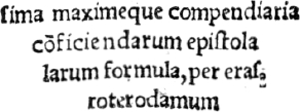 Fig. 50. The ‘Gromor’ Small Pica Roman [r 75] or Philosophie (1529) as it appears in Erasmus, Brevissima... epistolarum formula, Paris, [P. Gromors], 1529. Courtesy of the University Library, Ghent.
| |||||||||||||||||||||||||||||||||||||||||||||||||||||||||||||||||||||||||||||||||||||||||||||||||||||||||||||||||||||||||||||||||||||||||||||||||||||||||||||||||||||
[pagina 78]
| |||||||||||||||||||||||||||||||||||||||||||||||||||||||||||||||||||||||||||||||||||||||||||||||||||||||||||||||||||||||||||||||||||||||||||||||||||||||||||||||||||||
51. The ‘Vidoue’ Roman titling on Two-line Small Pica [r 7.5] or Deux points de Philosophie (1530)Vidoue used a third and somewhat smaller sized titling in the same style as his earlier ones, described above in (44) and (48). Size: Two-line Small Pica (Deux points de Philosophie); 24/23 Anglo-American/Didot points;: 7.5 mm. 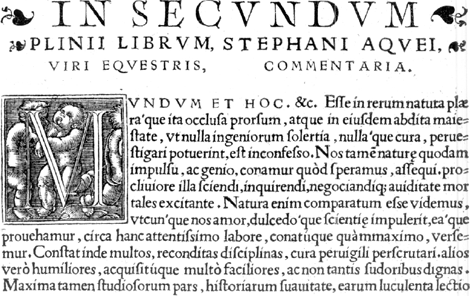 Fig. 51. The ‘Vidoue’ titling on Two-line Pica [r 7.5] or Deux points de Cicéro (1529) as it appears in E. de Laigue, In omnes C. Plinii... commentaria, Paris, P. Vidoue, 1530, f. a1. Courtesy of the Stadsbibliotheek, Antwerp.
| |||||||||||||||||||||||||||||||||||||||||||||||||||||||||||||||||||||||||||||||||||||||||||||||||||||||||||||||||||||||||||||||||||||||||||||||||||||||||||||||||||||
[pagina 79]
| |||||||||||||||||||||||||||||||||||||||||||||||||||||||||||||||||||||||||||||||||||||||||||||||||||||||||||||||||||||||||||||||||||||||||||||||||||||||||||||||||||||
Roman types by type size
| |||||||||||||||||||||||||||||||||||||||||||||||||||||||||||||||||||||||||||||||||||||||||||||||||||||||||||||||||||||||||||||||||||||||||||||||||||||||||||||||||||||
[pagina 80]
| |||||||||||||||||||||||||||||||||||||||||||||||||||||||||||||||||||||||||||||||||||||||||||||||||||||||||||||||||||||||||||||||||||||||||||||||||||||||||||||||||||||
| |||||||||||||||||||||||||||||||||||||||||||||||||||||||||||||||||||||||||||||||||||||||||||||||||||||||||||||||||||||||||||||||||||||||||||||||||||||||||||||||||||||
[pagina 81]
| |||||||||||||||||||||||||||||||||||||||||||||||||||||||||||||||||||||||||||||||||||||||||||||||||||||||||||||||||||||||||||||||||||||||||||||||||||||||||||||||||||||
References
| |||||||||||||||||||||||||||||||||||||||||||||||||||||||||||||||||||||||||||||||||||||||||||||||||||||||||||||||||||||||||||||||||||||||||||||||||||||||||||||||||||||
[pagina 82]
| |||||||||||||||||||||||||||||||||||||||||||||||||||||||||||||||||||||||||||||||||||||||||||||||||||||||||||||||||||||||||||||||||||||||||||||||||||||||||||||||||||||
| |||||||||||||||||||||||||||||||||||||||||||||||||||||||||||||||||||||||||||||||||||||||||||||||||||||||||||||||||||||||||||||||||||||||||||||||||||||||||||||||||||||
[pagina 83]
| |||||||||||||||||||||||||||||||||||||||||||||||||||||||||||||||||||||||||||||||||||||||||||||||||||||||||||||||||||||||||||||||||||||||||||||||||||||||||||||||||||||
| |||||||||||||||||||||||||||||||||||||||||||||||||||||||||||||||||||||||||||||||||||||||||||||||||||||||||||||||||||||||||||||||||||||||||||||||||||||||||||||||||||||
[pagina 84]
| |||||||||||||||||||||||||||||||||||||||||||||||||||||||||||||||||||||||||||||||||||||||||||||||||||||||||||||||||||||||||||||||||||||||||||||||||||||||||||||||||||||
| |||||||||||||||||||||||||||||||||||||||||||||||||||||||||||||||||||||||||||||||||||||||||||||||||||||||||||||||||||||||||||||||||||||||||||||||||||||||||||||||||||||
[pagina 85]
| |||||||||||||||||||||||||||||||||||||||||||||||||||||||||||||||||||||||||||||||||||||||||||||||||||||||||||||||||||||||||||||||||||||||||||||||||||||||||||||||||||||
Index of historical personal names Light numerals refer to the pages of the Introduction (pp. 1-9); bold numerals to the number of the Type descriptions (pp. 12 sqq.) or their side-notes.
| |||||||||||||||||||||||||||||||||||||||||||||||||||||||||||||||||||||||||||||||||||||||||||||||||||||||||||||||||||||||||||||||||||||||||||||||||||||||||||||||||||||
[pagina 86]
| |||||||||||||||||||||||||||||||||||||||||||||||||||||||||||||||||||||||||||||||||||||||||||||||||||||||||||||||||||||||||||||||||||||||||||||||||||||||||||||||||||||
| |||||||||||||||||||||||||||||||||||||||||||||||||||||||||||||||||||||||||||||||||||||||||||||||||||||||||||||||||||||||||||||||||||||||||||||||||||||||||||||||||||||
[pagina 87]
| |||||||||||||||||||||||||||||||||||||||||||||||||||||||||||||||||||||||||||||||||||||||||||||||||||||||||||||||||||||||||||||||||||||||||||||||||||||||||||||||||||||
| |||||||||||||||||||||||||||||||||||||||||||||||||||||||||||||||||||||||||||||||||||||||||||||||||||||||||||||||||||||||||||||||||||||||||||||||||||||||||||||||||||||
[pagina 88]
| |||||||||||||||||||||||||||||||||||||||||||||||||||||||||||||||||||||||||||||||||||||||||||||||||||||||||||||||||||||||||||||||||||||||||||||||||||||||||||||||||||||
SummaryThis article describes fifty-one Roman typefaces, appearing in Paris from 1501 to 1530. Its introduction addresses three main points. First, the coming-of-age of Parisian typography and the seasoning of a general reading public to Roman letterforms. Second, the ways of type procurement, either by individual ownership of punches and matrices, or by concentration in and commercialization through typefoundries. Third, the problem of identifying the punchcutters involved. The paper comprises a description of the founts in their order of first occurrence. At the end of the paper a table lists them by size. | |||||||||||||||||||||||||||||||||||||||||||||||||||||||||||||||||||||||||||||||||||||||||||||||||||||||||||||||||||||||||||||||||||||||||||||||||||||||||||||||||||||
ResuméCet article décrit cinquante et un caractères romains apparaissant à Paris entre 1501 et 1530. Son introduction envisage trois aspects. En premier lieu, la marche lente de la typographie française vers son épanouissement après 1530 et l'assimilation du caractère romain par le public commun. Puis, les méthodes d'acquisition matérielle des fontes, soit par la possession individuelle de poinçons et matrices, soit par l'entremise des fonderies centralisées. Finalement, le problème de l'identification des graveurs de caractères. L'article contient une description de chaque fonte par ordre chronologique, un appendice les classifiant par corps. | |||||||||||||||||||||||||||||||||||||||||||||||||||||||||||||||||||||||||||||||||||||||||||||||||||||||||||||||||||||||||||||||||||||||||||||||||||||||||||||||||||||
SamenvattingDit artikel beschrijft eenenvijftig Romeinen gebruikt door Parijse drukkers in de periode 1501-1530. In de inleiding komen drie aspecten aan bod. Vooreerst, de langzame gang naar volwassenheid van de Parijse typografie en de aanvaarding van de nieuwe lettervorm door een algemeen lezerpubliek. Verder, de wijze van commercialisering van de drukletters, hetzij door het individuele bezit van stempels en matrijzen, hetzij via centrale lettergieterijen. Ten slotte, het probleem van de identificatie van de lettersnijders. Het artikel omvat een beschrijving van iedere letter in chronologische volgorde. Een appendix schikt ze per corps. |
| ||||||||||||||||||||||||||||||||||||||||||||||||||||||||||||||||||||||||||||||||||||||||||||||||||||||||||||||||||||||||||||||||||||||||||||||||||||||||||||||||||||

